The Lenten roses were early, showing their buds prematurely at the new year as a mark of the mild winter. They have been gathering pace in these damp weeks since to arrive on cue where they should rightly be to brighten February. This is their month and their new life is my trigger to make a start clearing around them.
Revealed again, free of last year’s debris, they rise to their full potential to stand elegantly poised on slender stems. Their flowers, bowed and hooded against the elements, give little away and remain mysterious until you upturn them in your hand to glimpse the complexity of their interiors. We group them in shadowy places alongside the steps and are lucky here with our slopes, which allow you a glimpse from the underside into their secret interiors.
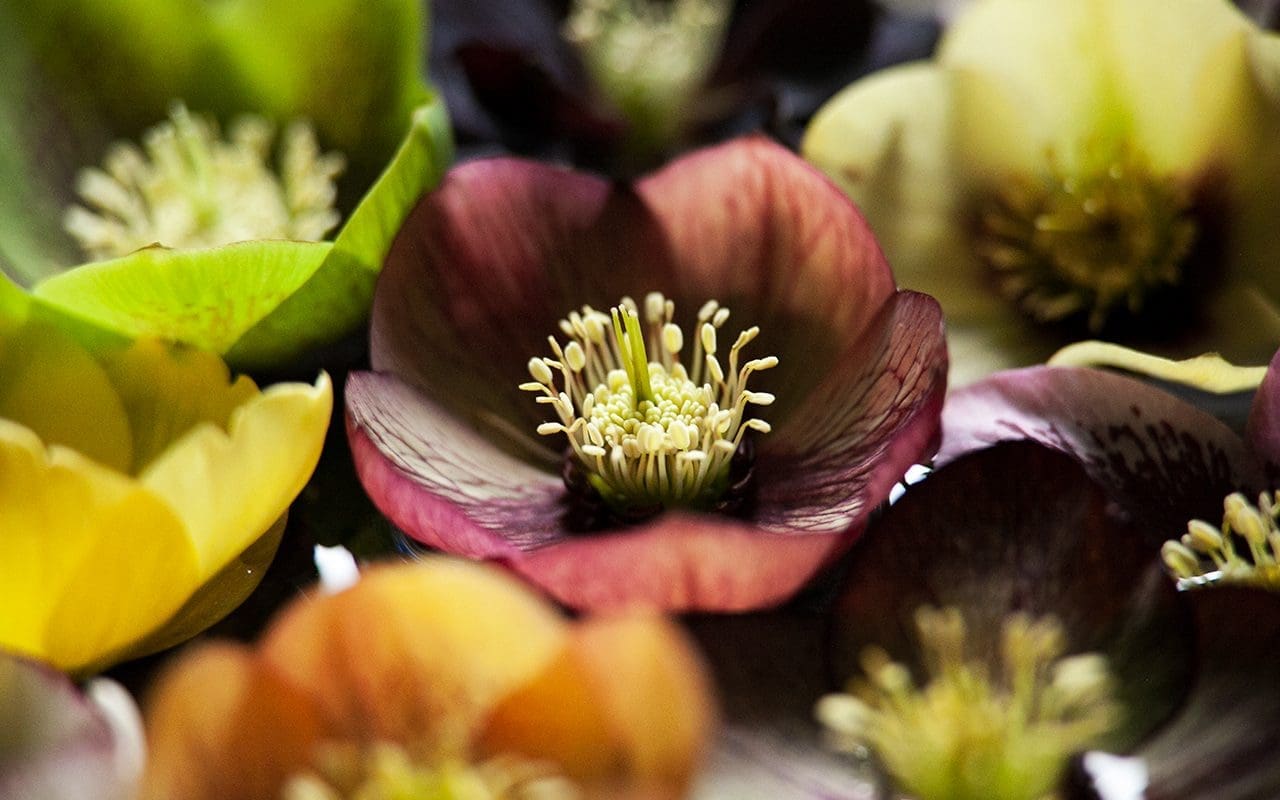
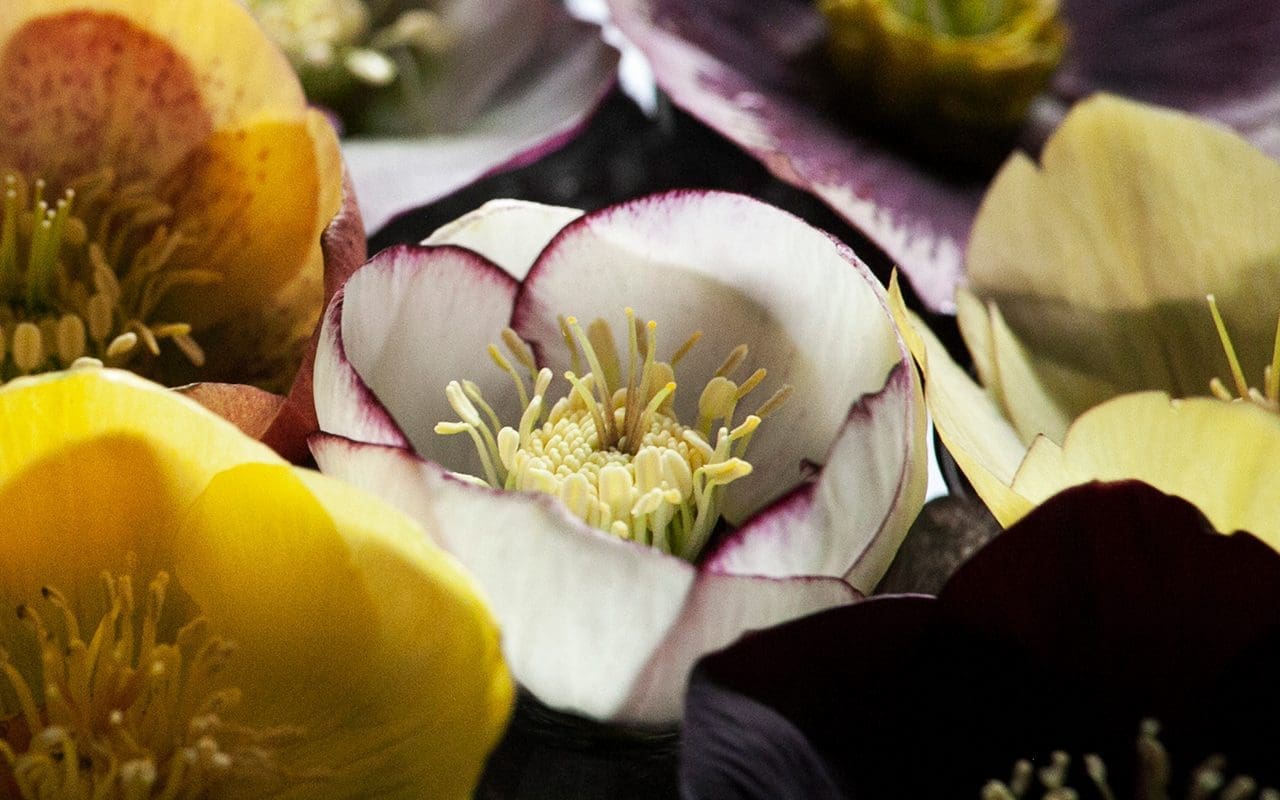
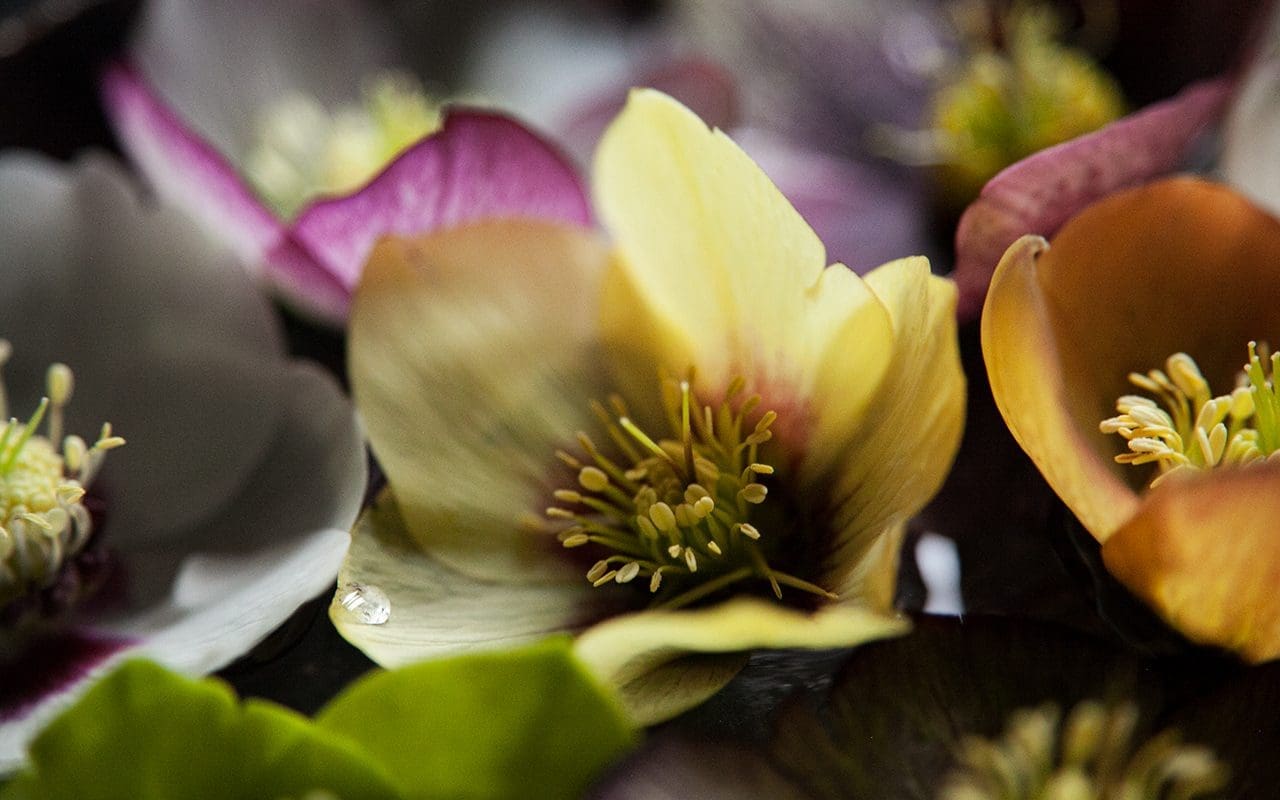
My childhood gardening mentor and friend, Geraldine, always had a bowlful on her kitchen table at this time of year. She had learned that, since the stems do not cut well, this is the best way to enjoy them up close, floating on water like offerings. Back when I was a child and Geraldine and I were swapping seedlings, we were quite content with what I would now see as murky pinks and impure whites. We had no idea then that Elizabeth Strangman and Helen Ballard were already selecting and refining the beginnings of the first good forms, many of which led to the choice we have today. Ashwood Nurseries have made an art of selection and are my go-to nursery for hellebores, but I am always on the look out at this time of year, because there is nothing like finding a new favourite.
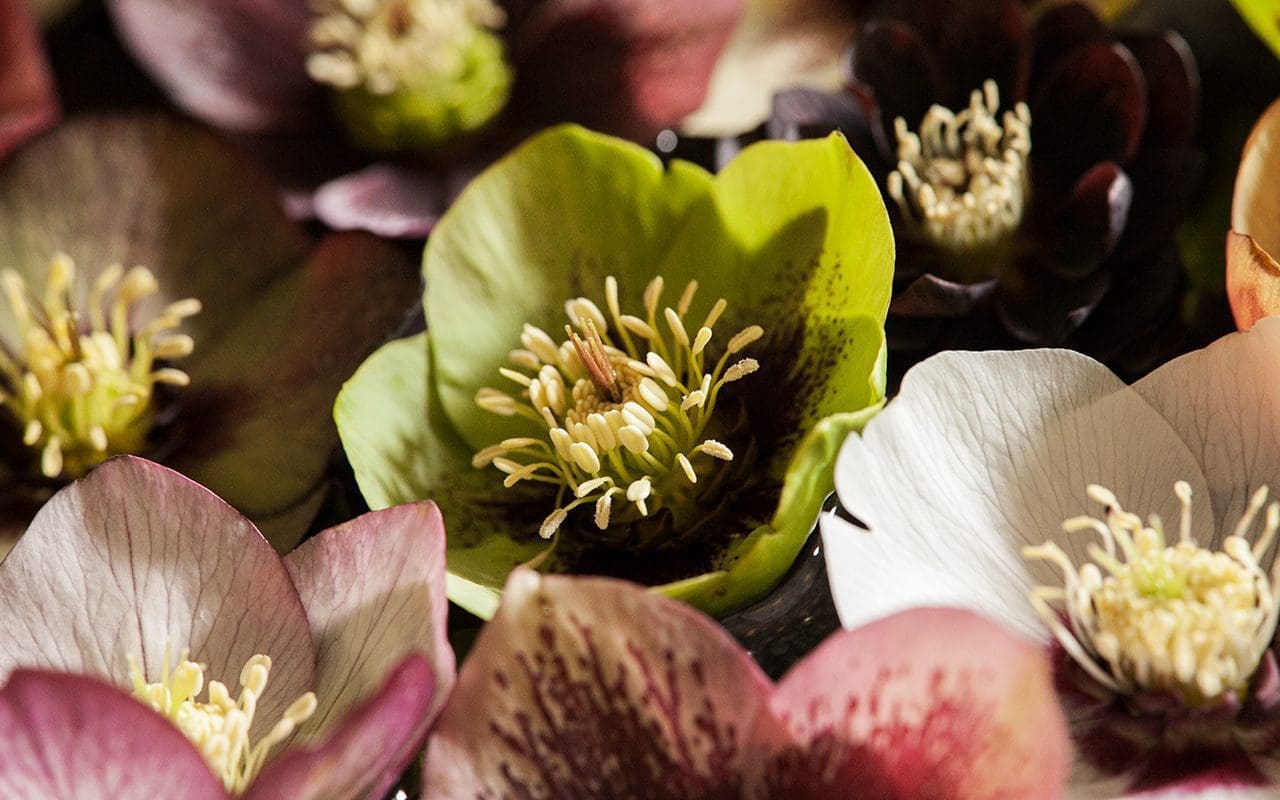
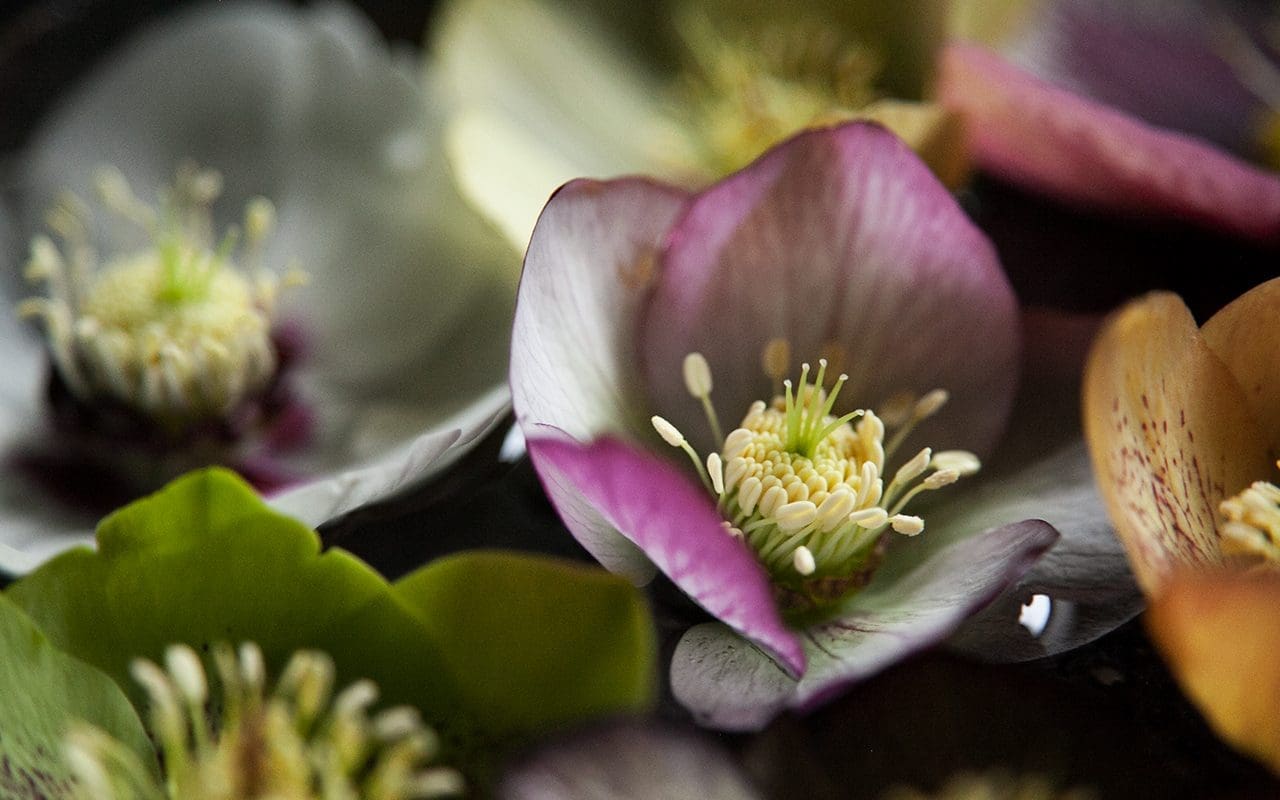
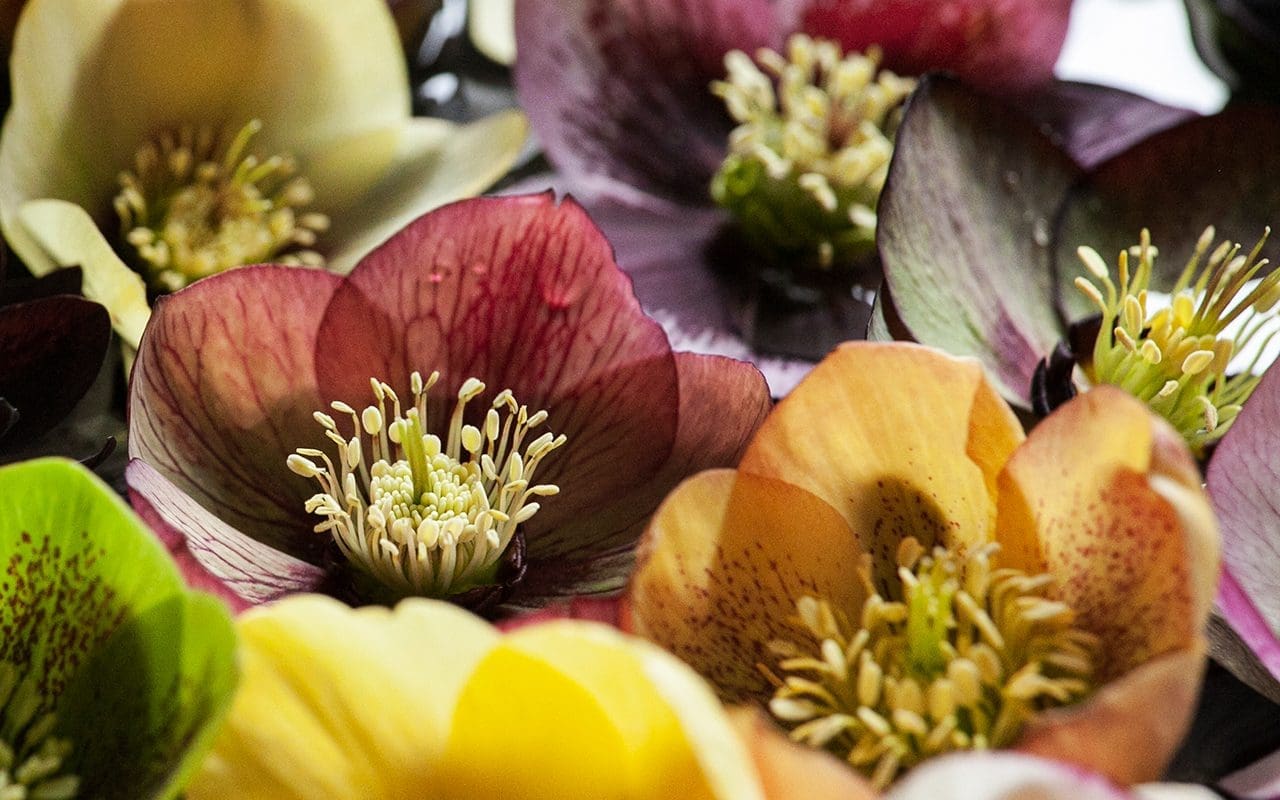
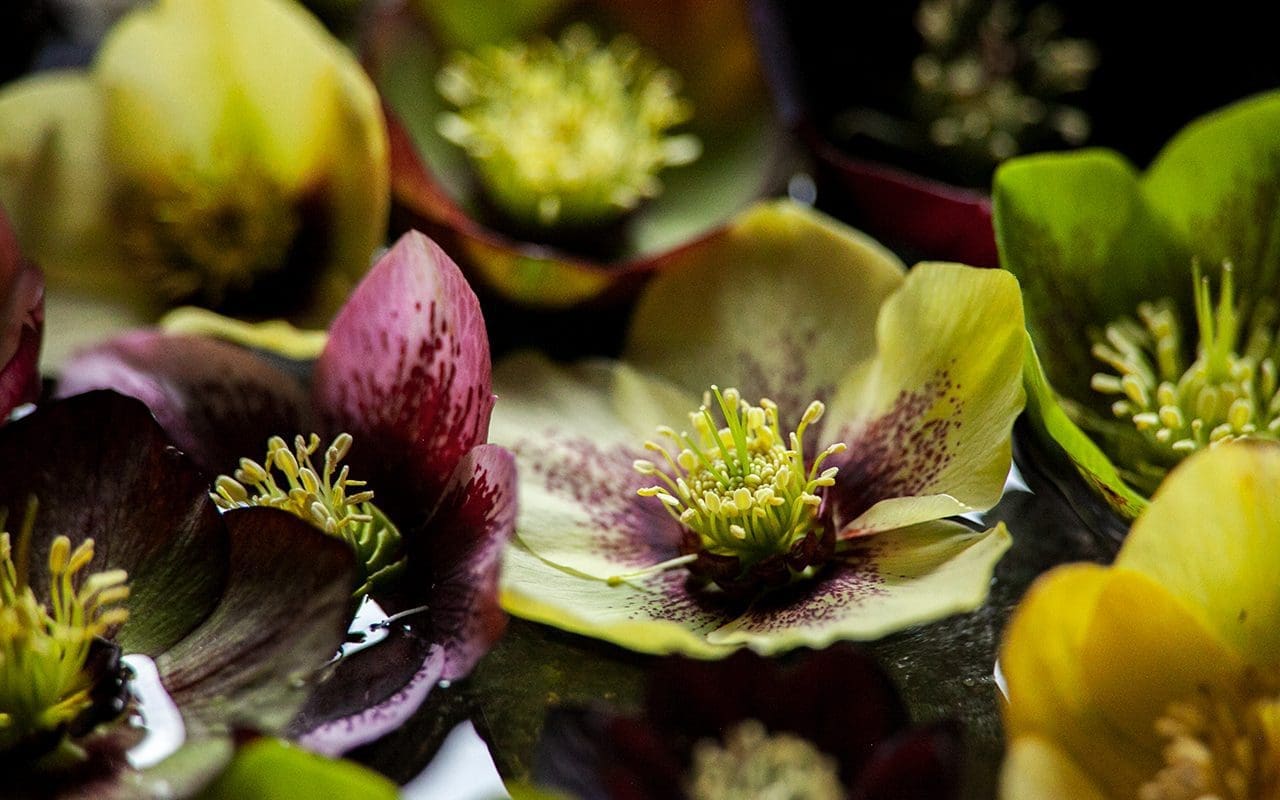
As with any infatuation, I have become very particular about the forms I grow here. I favour the singles, which sit better with the naturalistic mood of the garden and look for good poise and well-proportioned flower. You know when you see it once you get your eye in.
The cool conditions that the hellebores need in summer are rare on our slopes and the pools of shadow that I am nurturing under the trees have to be rationed. The hellebores come high on the list of shade-lovers I provide for and I have grouped them according to colour, moving from tree to tree and changing the mood accordingly. Lime-green selections to throw the black forms into relief under the Hamamelis x intermedia ‘Gingerbread’, meaty reds and plums together with the bronze foliage of Viola riviniana var. purpurea beneath the medlar. Yellows completely on their own or with the green of ferns, so that their brightness shines out in the way that primroses do on a shady bank.
The whites get their own place too as they project a clean mood and are good with snowdrops and I like to see the picotee selections together so that the fineness of their markings is not lost in a crowd. Although I am not an admirer of the double forms, particularly the pastels, which feel overbred and out of place at this time of year, I do treasure a dark plum double of good form. We have it growing on its own under the wintersweet and I like it for its ancient, medieval feeling. When afloat it looks like an exotic waterlily.
Once the hellebores begin to go to seed, I remove all but an occasional stem in each group to curb their offspring. The parent plants can live many years, decades even, and are best without the competition of juveniles, but I am keen to see, by grouping my plants carefully, if they will spawn the odd treasure. Most will be inferior to their hand-selected parents, but some may have a special something. The seedlings retain a certain charge of expectation. The excitement of a possible new addition to the spectrum.
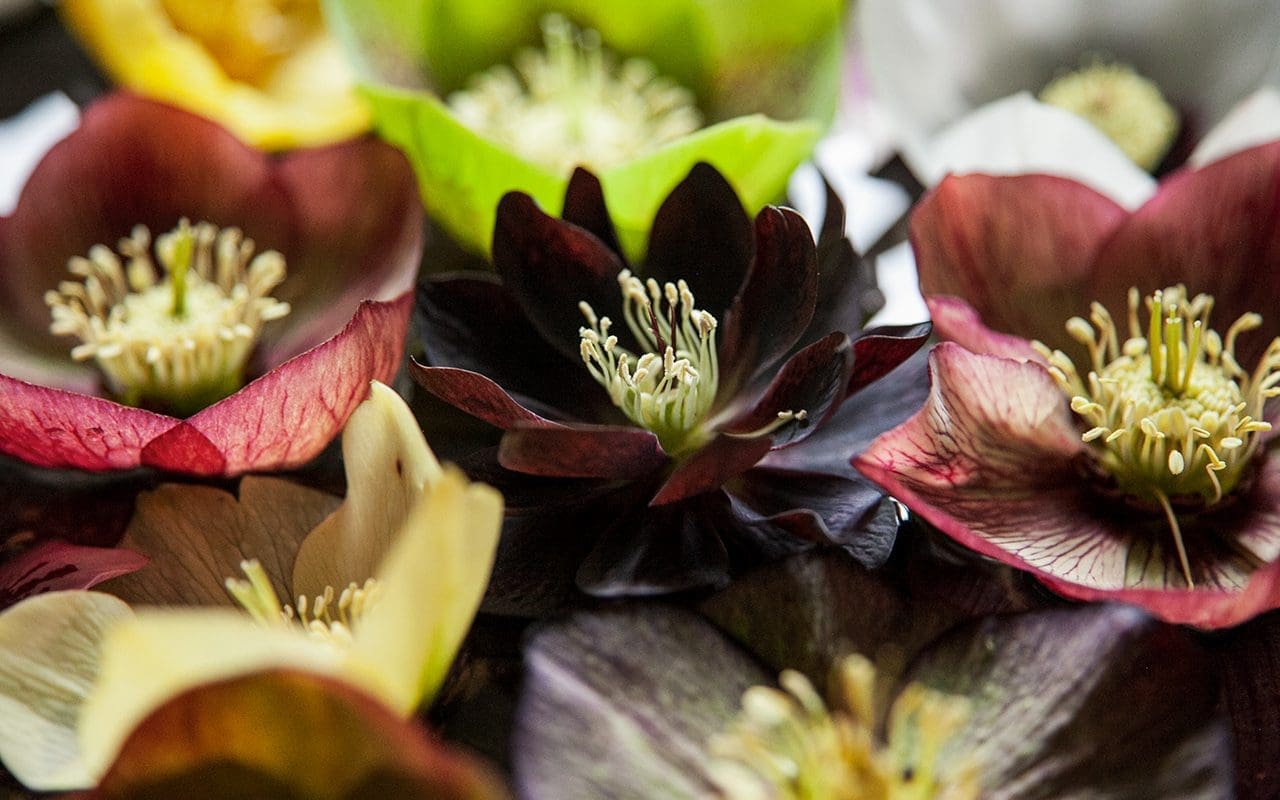
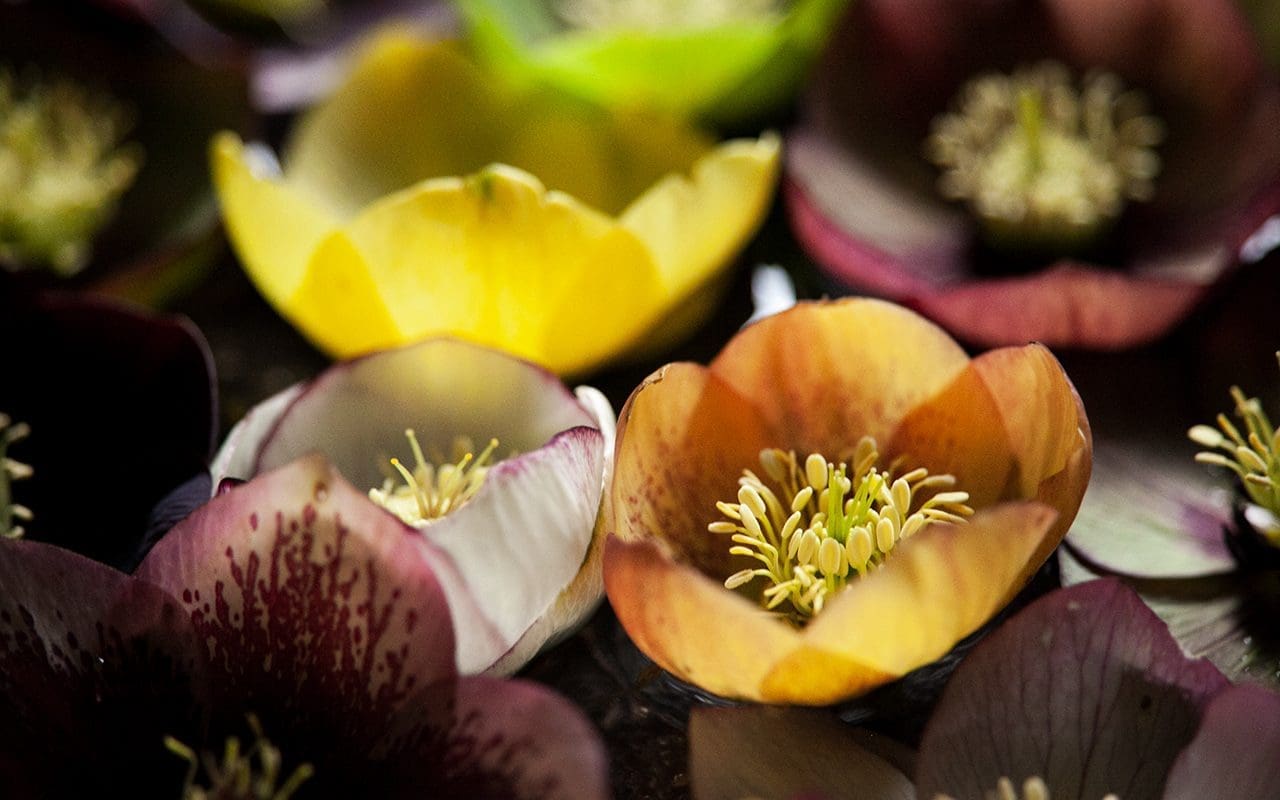
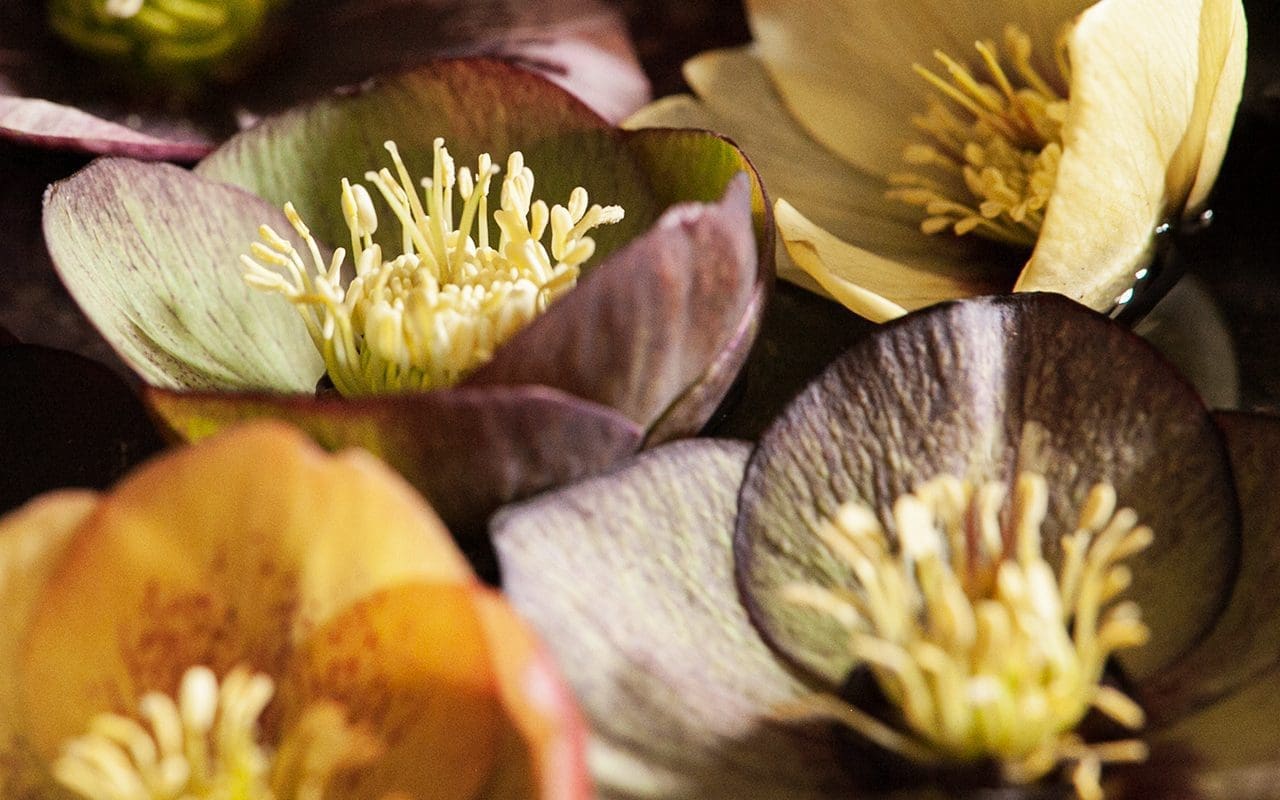
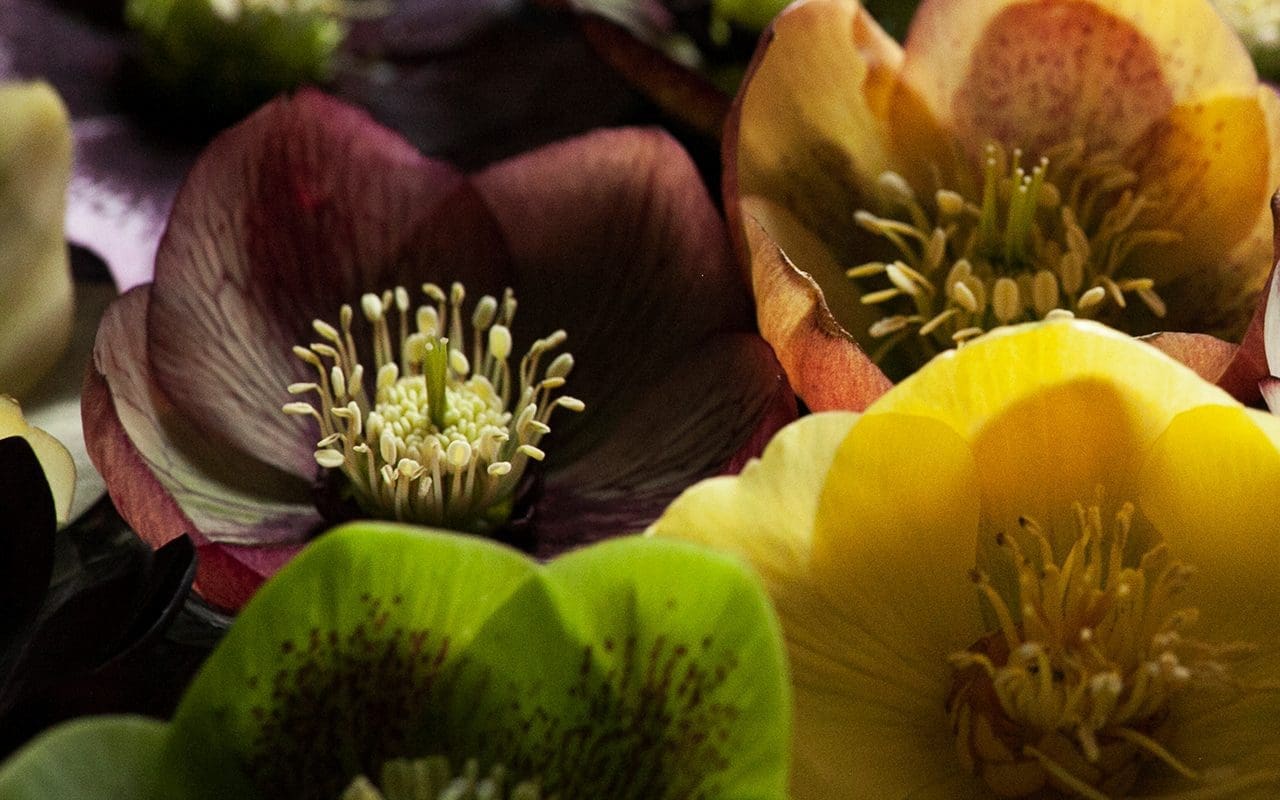
Words: Dan Pearson | Flowers & Photographs: Huw Morgan
Published 8 February 2020
Every autumn, with late September sun on my back and the prospect of this very moment in mind, I spend an afternoon potting up the winter-flowering iris. A winter without them would be a winter without this particular prospect. A spear of optimism that pushes life regardless, into the dark months.
Here I save my hottest, driest spots for autumn-flowering Galanthus reginae-olgae, Amaryllis belladonna, Sternbergia lutea and the perennial, strappy-leaved Algerian Iris and so keep to the habit of growing the bulbous winter iris in pots. We are now spoiled for choice as there are so many named forms. The earliest to flower is Iris histriodes, which is distinct for having slightly shorter growth and wider flowers than Iris reticulata. There are also crosses between them and the yellow-flowered Iris winogradowii. Of them all I prefer the elegance of the Iris reticulata, which draw a more finely-penned line, but they are all worth exploring and every year we trial two or three new varieties and return to a favourite or two to reacquaint ourselves.
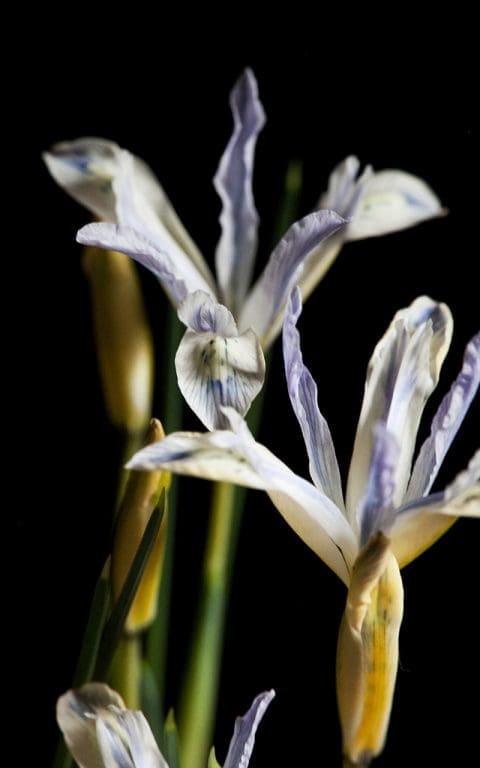
I have learned over the years that growing them in pots is the best way to grow them here. Hailing from Turkey, where they have a summer bake ahead of them, they make the most of the winter rains and the short and furious growing season. A winter which is all about readying for spring and where rest is not an option. They bring all of that energy with them and are more than happy to do their best in our benign climate in Britain, but our summer is their downfall. Like tulips, they need the bake and the dry come the summer and you have to find them a free-draining site which emulates their homeland if you are to be successful in keeping them long-term in open ground. The damp of the West Country, in combination with our heavy soil, means that I have the tiniest slivers of such ground at the base of south-facing walls that would see them doing well. This is not to say that it is not worth trying, but if you do have the right position, plant them deep at 15 to 20cm so that they are below the runs of mice and voles.
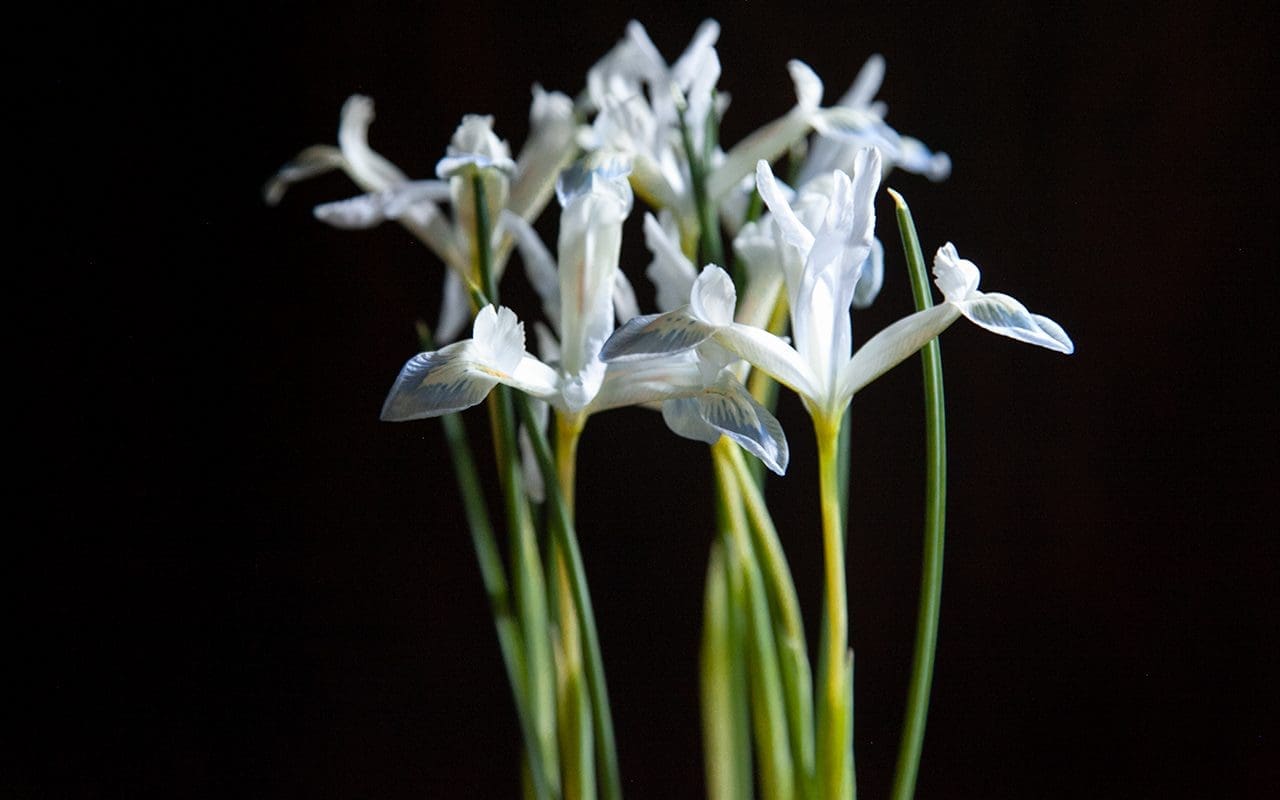
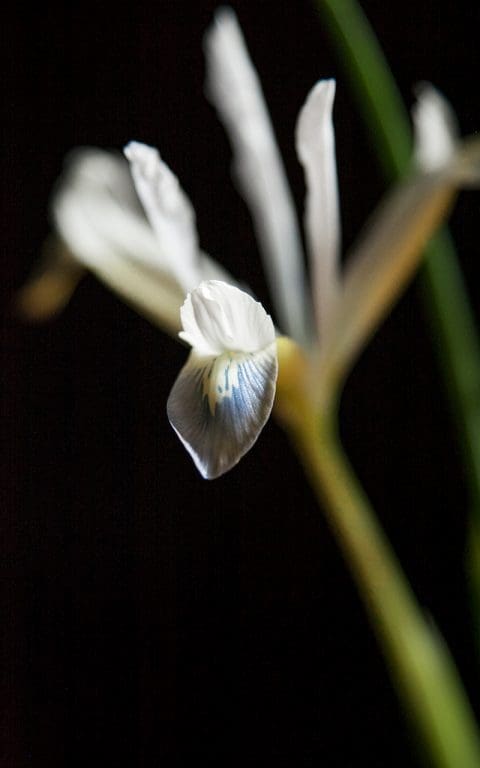
The bulbs are small and you need no more than five to a pot. Any more, or plant them too densely, and the elegance of the flowers is lost in the crowd. The bulbs are planted deep in the pot and put in the frame to keep them on the dry side and with just that little bit of extra protection to steal a week or perhaps a couple on the winter. The first spears of foliage were visible at new year this year. These early signs draw you back regularly to check on the shift which takes place rapidly as soon as you see the papery, translucent sheath that protects the flower buds. If you wait until this moment and bring them into a cool room in the house, the pointed buds will rise fast and silently in a day. If you are prepared to cheat again and bring them into slightly more warmth you can witness the petals unfurling like a Chinese fortune fish that curls in your hand.
Inside the flowers last for no more than a weekend, but you do get to witness them up close and intimately as I am doing now as they sit in front of me on my desk. Then you will also be able to take in their fine but certain perfume, like a cross between primroses and distant violets. This year, the tallest of the three that have come together this weekend is ‘Painted Lady’ (main image), the first to flower. Yellow, speckled buds open palest lavender, the blue leopard spots staining the tips of the petals as if they were bleeding. Next to flower was ‘Frozen Planet’, again pale but well-named for the ice-blue cast that intensifies to colour the whole of the falls. Last of the three is ‘Fabiola’, a substitute made by the nursery. Although my “no substitutes” rule is usually hard and fast, I am pleased to have this one. It is always good to have a dark form in the group, so as to have the gold flare in the throat set off by rich royal purple velvety falls.
We love them all, but I do not have the heart to keep them inside for long, since they last a fortnight outside in the shelter of the house and we return to them daily to enjoy their every moment.
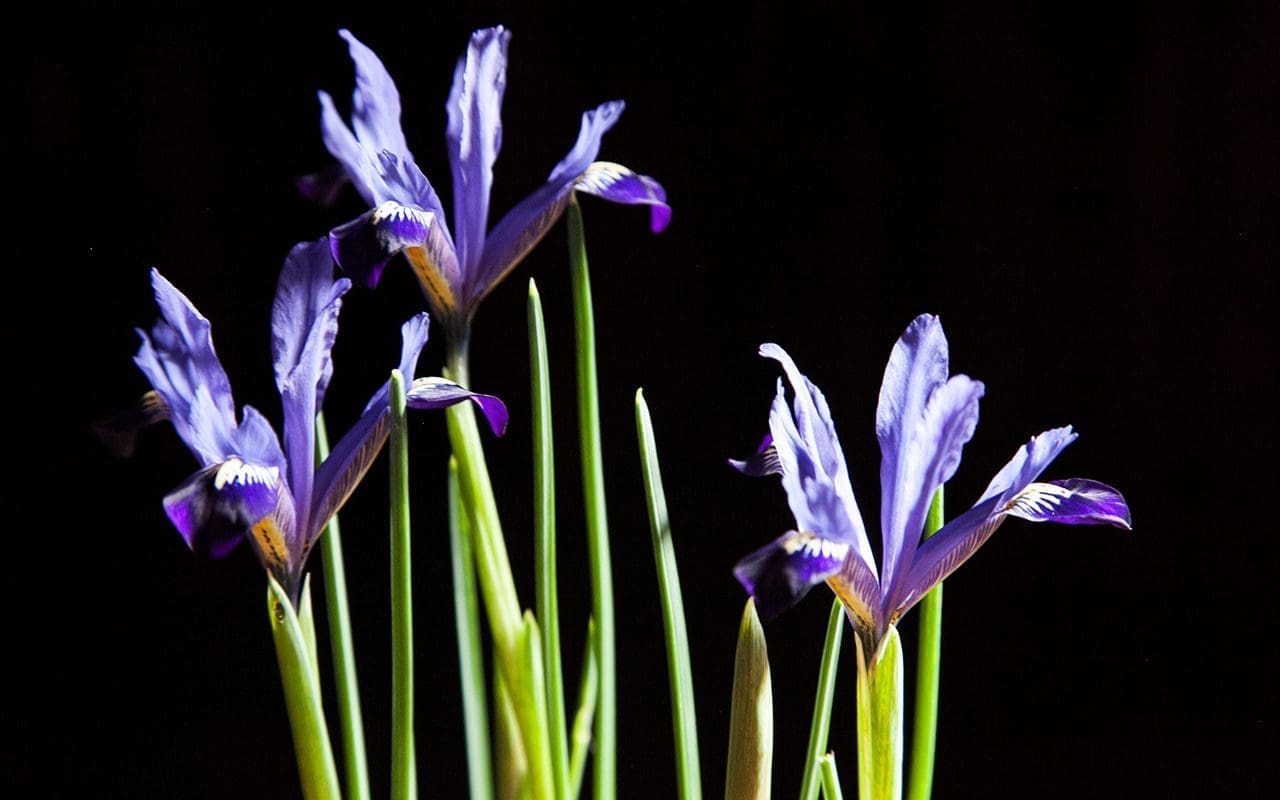
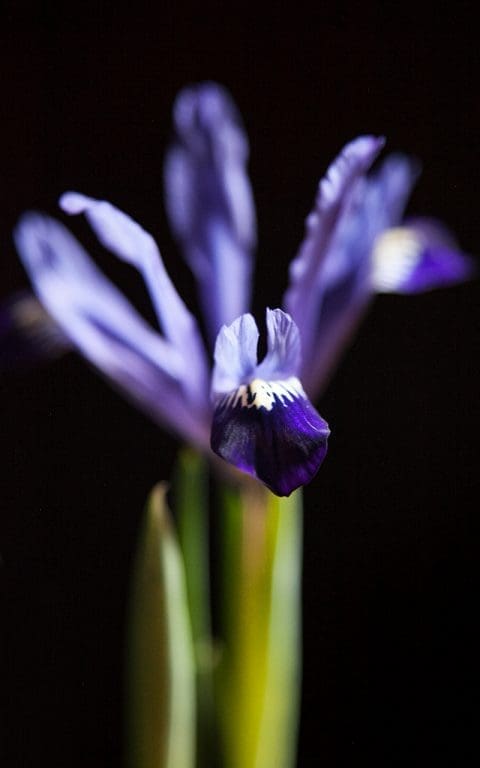
Words: Dan Pearson | Photographs: Huw Morgan
Published 1 February 2020
There was a heavy frost this morning and we were suspended for a while in a luminous mist. The wintry sun pushed through by lunchtime, the melt drip-dripping and the colour of thaw returning as the unification of freeze receded. Undeterred the Coronilla valentina subsp. glauca ‘Citrina’ emerged unscathed, liberating their sweet honey perfume in the sun.
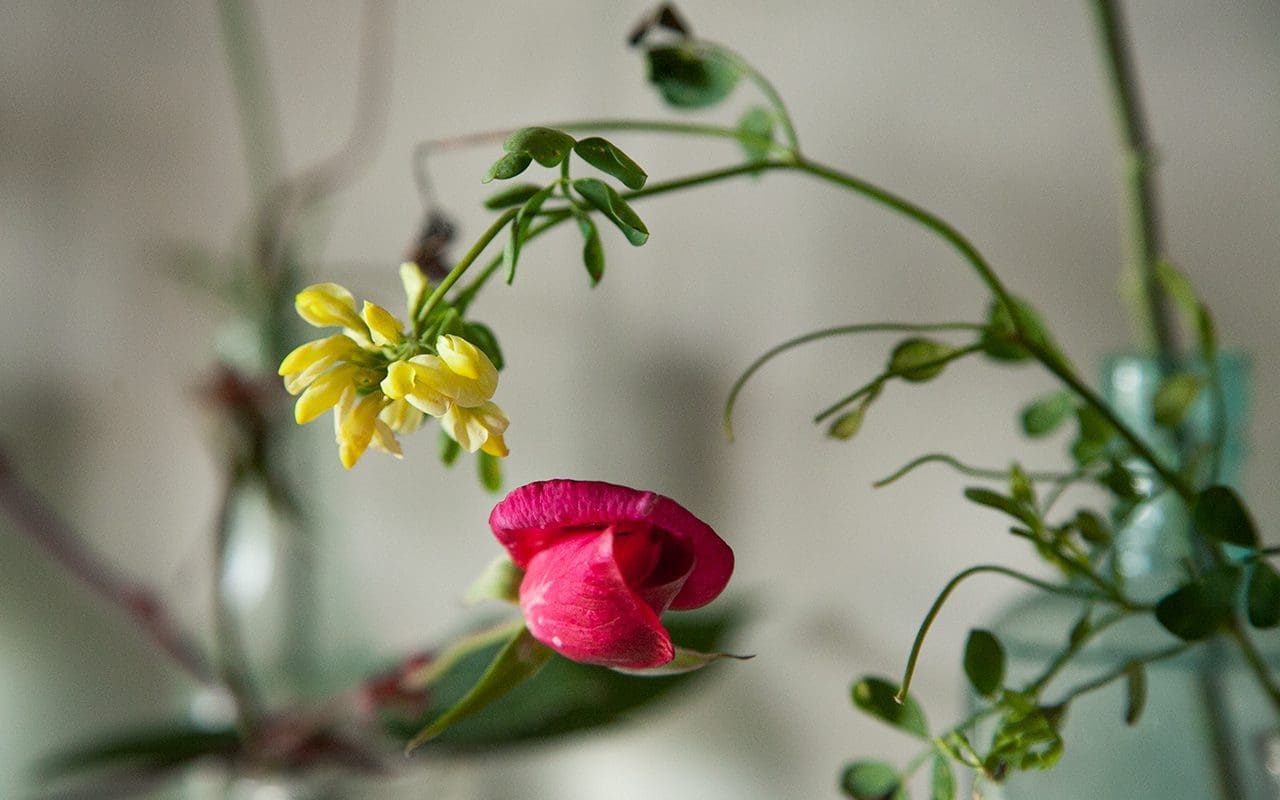
We went on a hunt for flower to see what there might be left for the first winter mantlepiece. The pickings, now rarefied, feel held in a season beyond their natural life. A rogue Lunaria annua ‘Chedglow’ misfiring, but welcome for the reminder of the hot violet which you have to imagine as you move the seedlings around to where you want them to be in the autumn. My original plants, a dozen grown from seed two years ago, are now gone. Last year’s pennies threw down enough seed immediately beneath to need thinning and the transplants allowed me to spread a new colony along the lower slopes of the garden. Being biennial, it is good to have two generations on the go so that there will always be a few that come to flowe,r but enough to run an undercurrent of lustrously dark foliage in winter. It is never better than now, revealed again when most of its companions have retreated below ground.
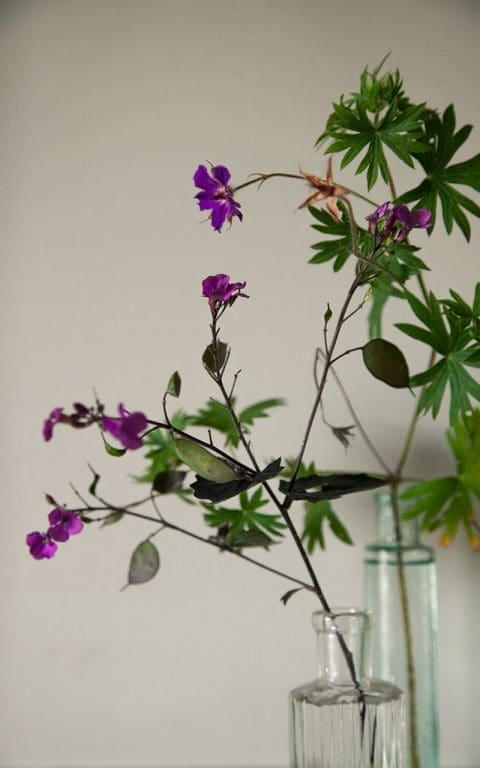
The reach of the Geranium sanguineum ‘Tiny Monster’ is now pulling back to leave a shadow where it took the ground in the summer. It has been flowering since April, brightly and undeterred by all weathers. This larger than life selection of our native Bloody Cranesbill shows no signs of stopping as the clumps steadily expand. It is a slow creep, but a sure one. Short in stature at no more than a foot, you have to team it carefully if it is not to overwhelm its neighbours. We also have the true native G. sanguineum, grown from seed collected from the sand dunes on the Gower peninsula in Wales, and teamed with Rosa spinosissima from the same seed gathering. The two make a fine match, the geranium scrambling through the thorns of the thicket rose.
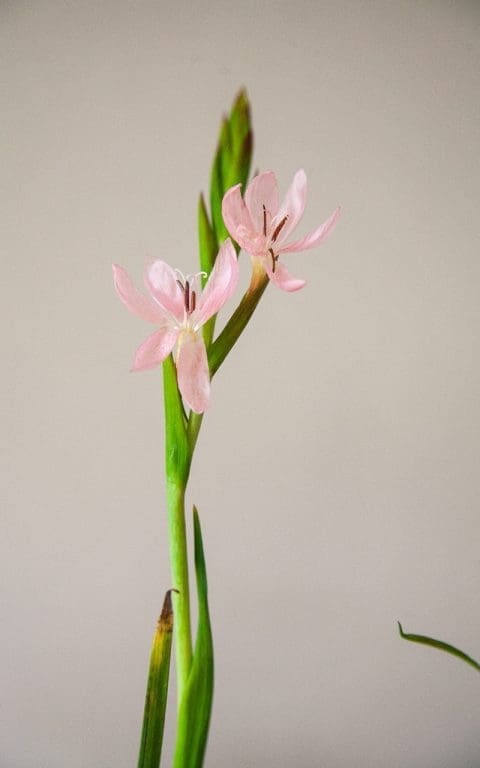
The pink Hesperantha was a gift from neighbours who gave us a mixed bag of corms including the earlier flowering H. coccinea ‘Major’. This hot red cousin flowers when there is heat in the sun, but gives way to this delicate shell-pink form (which we think is most likely to be ‘Mrs Hegarty’) as the days cool in October. I am not a fan of delicate pinks, preferring a pink with a punch, but it is hard not to love this one when it appears. I like it for standing alone at this time of year and for not having to compete for being so very late in the season. In terms of where they like to grow though, Hesperantha hail from open marshy ground in South Africa so you have to find them a retentive position with plenty of light to reach their basal foliage. I have them on the sunny side of Aster ericoides ‘Pink Cloud’ which they come with and then go beyond.
Equally hardy, and one of the longest-flowering plants in the garden, is the Scabiosa columbaria subsp. ochroleuca whose delicate pinpricks of lemon yellow are held high on wiry stems and are still enlivening the skeletons of Panicum and Deschampsia that are now collapsing around them. Even now they are a magnet for the hardiest bees and the odd peacock butterfly that ventures out in the weakening winter sun before hibernating.
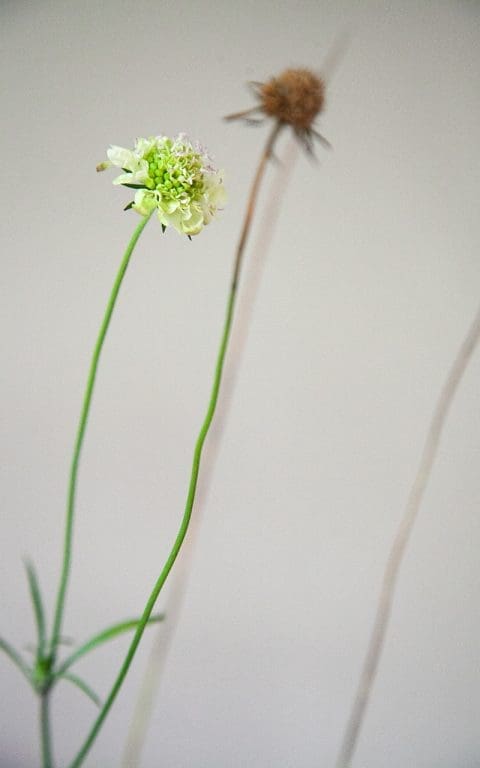
Aster trifoliatus subsp. ageratoides ‘Ezo Murasaki’ is our very last aster to flower, but its season is still longer than most. I love its simplicity and soft, moody colour, but it has been out for so long now that sometimes I forget to look. This is one of the joys of the mantlepiece and of hanging on so late to make you refocus. Not so Rosa x odorata ‘Bengal Crimson’, for it is hard to pass by this strength of colour in the gathering monochrome of winter. I have given our plant the most sheltered corner I have, because it is always trying to push growth which gets savaged by cold winds. Here, in the lee of the wall at the end of the house, it flowers intermittently, often through January, paled then by the cold, but always welcome. Close by and also basking in the shelter of the warm wall is Salvia ‘Nachtvlinder’, another plant that would continue to flower uninterrupted if we did not have the freeze.
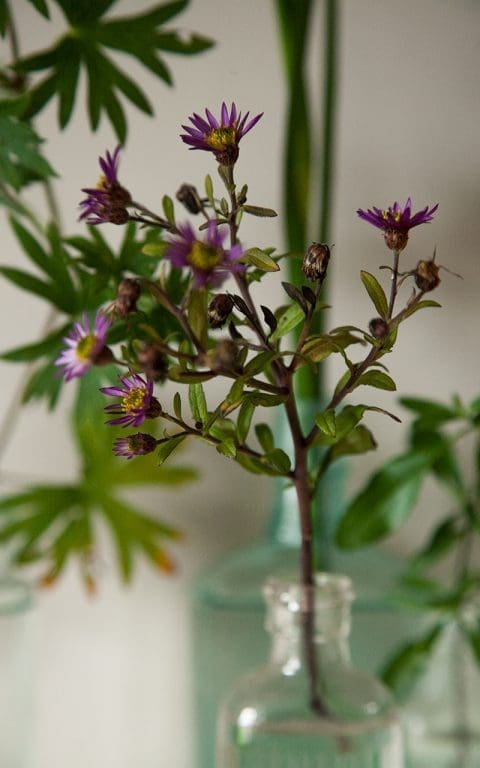
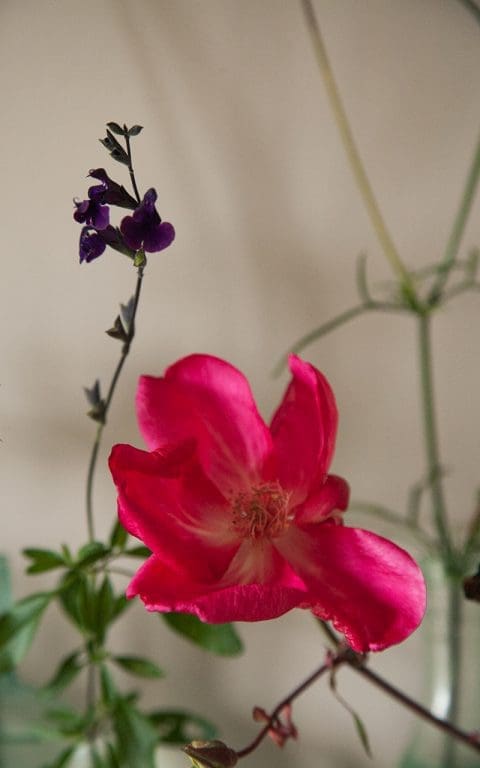
Next year I will protect the spider chrysanthemums, which come so late and need it to survive the frosts. This is one of the few that have survived the recent cold spell. I have not grown ‘Saratov Lilac’ before, but have taken cuttings which are in the frame to try again next year. I have also ordered several more to test my end of season resolve and hope a make-shift shelter of canes and sacking will suffice when the weather cools in October. We got away with it when I grew them in London, but not here where the frost is reliable and helps us to respect the season.
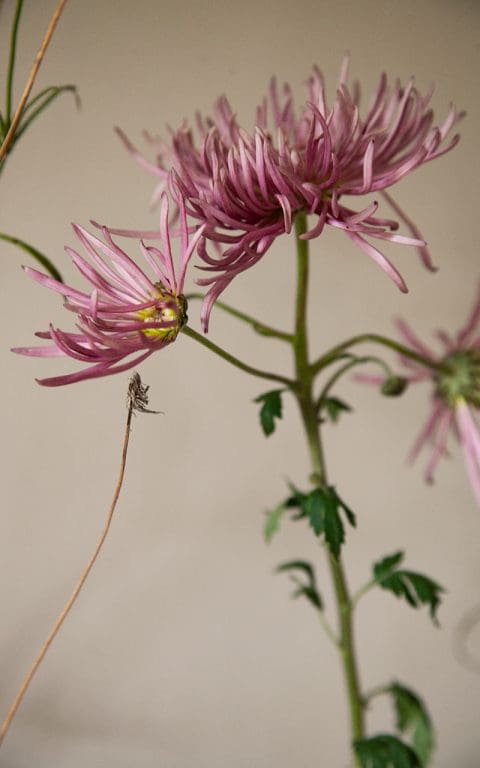
Words: Dan Pearson | Photographs: Huw Morgan
Published 7 December 2019
The Cornelian cherry have been expectant for the better part of January. Round buds plump and peppering the branches. Look closely at the beginning of February and you see the dark casings that hold them tightly, ruptured and revealing a seam of gold. I return daily as they gather momentum, passing the witch hazel, which is already perfuming the exit from the garden, and crossing the track to the ditch where I have planted a grove of Cornus mas. Here, staggered on the steep slopes, they step from one side to the other in a group of half a dozen to frame the passage the bridge makes across the water.
I am eager for life this far into winter and the cornus budburst happens at the same time that the snowdrops claim these last two weeks of February and as they pass the baton to the primroses. I have combined the three here deliberately and en masse, so that the crossing becomes an event to focus the near horizon. With the waning skeletons of the garden now behind me, the energy in the cornus help start to move things forward. One at a time, but quickly gathering pace, the darkness in the bare branches is eclipsed by a myriad tiny cadmium yellow flowers of invigorating intensity. Each bud contains up to twenty tiny flowers that are as much stamen as petal, but the accumulation of thousands make the trees appear to be spangled with an inner light. With the snowdrops and primroses they are a magnet for early pollinators.
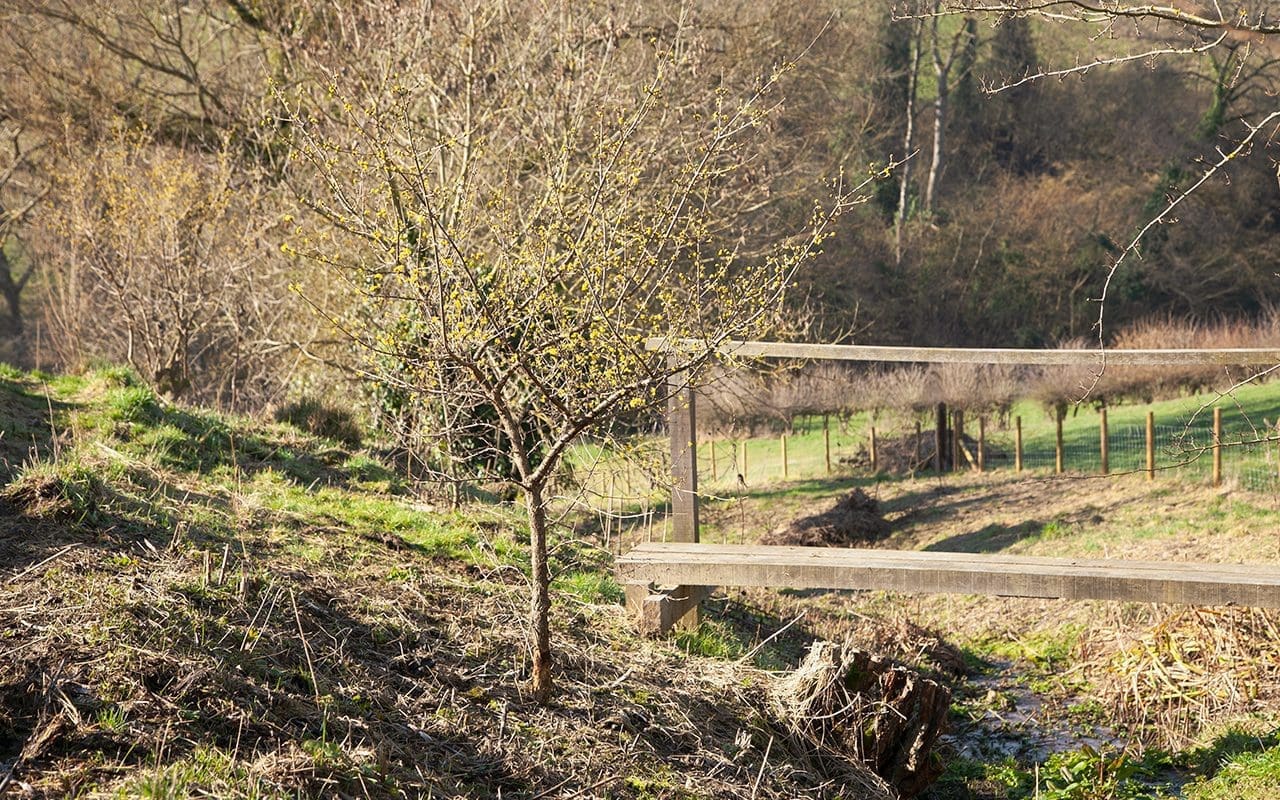
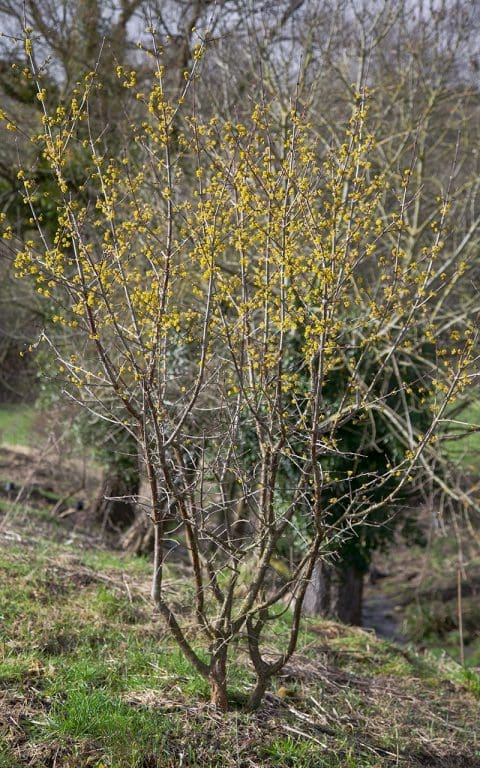
The cornus are young and are currently not much taller than myself. I brought them in three years ago as root-balled specimens to replace the brambly hedge that had swallowed this little ravine. Cleared and opened up again the banks have been host to meadowsweet, willowherb and other marsh-loving perennials. Though they are very slow growers – creating a wood so dense it sinks in water and is highly prized for making tools – I hope that eventually they will grow to about the height of a hawthorn and touch in places where I have planted them close enough together. In time, flaking limbs, branching low and twisting give the trees winter character – a contorted, Japanese quality – and me the opportunity of raising the canopy by pruning out the understory. Something to look forward to and deliberate upon whilst doing so.
I watched for the first couple of years to find the places where the cornus might be at home, because I knew they would not take the wetness that our native Cornus sanguinea is happy with. Although widespread in Southern Europe and Southwestern Asia, their preference is for ground that holds moisture and doesn’t dry out entirely in the summer, but that never gets waterlogged. It has been an education to see how they have already shown me where they like to be. I hit water when planting two, the springs in the bank not being visible above ground. Since the land is steeply sloping I felt it would be free-draining even with running water, and so I went with it. Sure enough, now that the trees have had two summers to settle in, I can see that, given a damp position they are already growing more lushly than those on the higher, dryer ground. Only one has suffered from being planted in a boggy pocket, and seemed slowly to be going backwards, although it has started to shoot from the base, so may be making its own adjustments. Time will tell as the conditions express themselves further in growth, but for now all of them are happy.
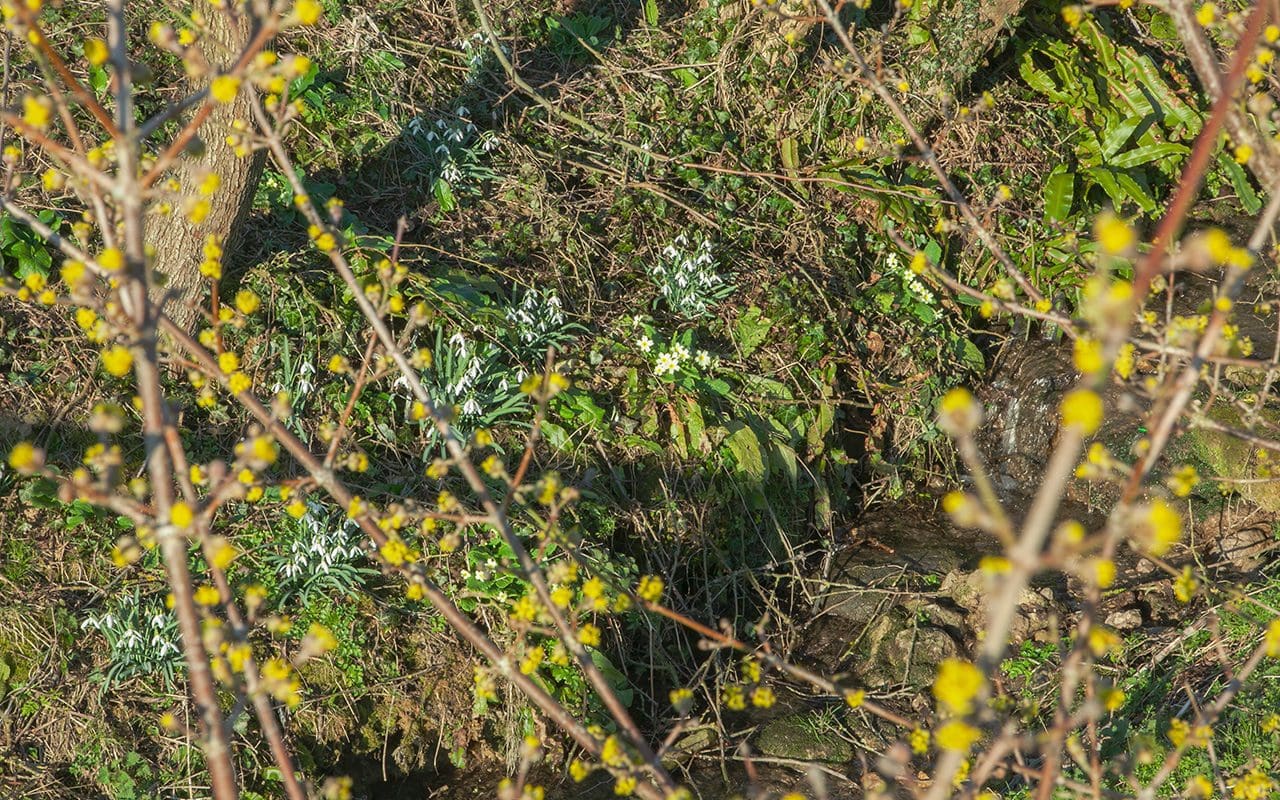
My mission now is to extend the snowdrop trail that I have growing under the nearby hazel to follow their canopies. The snowdrops will be sure to let me know where the ground is too wet, but they are likely to enjoy the drying effect that the roots of the cornus will have in the summer when in growth. The trees will be in flower for the best part of a month, so I have underplanted them with Tenby daffodils which will pick up as the snowdrops wane and the cornus dim.
In summer, the Cornelian cherry is easy on the eye in a natural setting, for its leaves are not unlike our native dogwood. Late in summer, in a warm position where the fruit can ripen, you will see that they are hung with small drops of ruby red, which are highly prized by birds. Though too tart for us to eat raw, they have been an important food source for over 7000 years in Greece, where they are still made into jam and raki. As autumn comes the foliage colours russet and gently red and, by the time the leaves drop, you will already see the embryonic buds, ready and waiting for the time when we gardeners are hungry for signs of life.
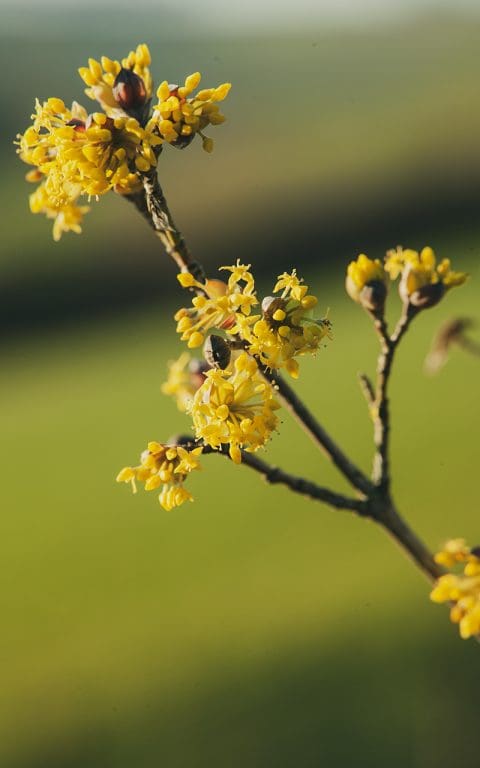
Words: Dan Pearson / Photographs: Huw Morgan
Published 16 February 2019
Four years watched from seed
Pale crook necks rise as all sleep
Ruff-collared aconite
Words: Huw Morgan & Dan Pearson / Photograph: Huw Morgan Published 12 January 2019
The Lenten Rose was one of my first infatuations as a child, rising like a phoenix from the leaf mould when little else was braving winter. We had discovered a solitary plant in a wooded clearing of our derelict garden and, though it was nothing special by today’s standards, it had survived the forty years of neglect that had finally overwhelmed the previous owner. I remember the excitement, the elegant outline of the hooded flower and lifting the plum and green reverse to reveal the boss of sheltered stamens.
In the years since, the excitement of their reappearance each February has never dimmed. In fact I depend upon them as their energy gathers and pushes against the last of the winter. Close observation over time has allowed me the opportunity of getting to know them better; the places they like to be, their surprising resilience and longevity and where to use them so that they offer you their very best. I have also developed a keen eye, winkling out the ones that have been superseded in terms of colour and form, so that I am only growing my absolute favourites.
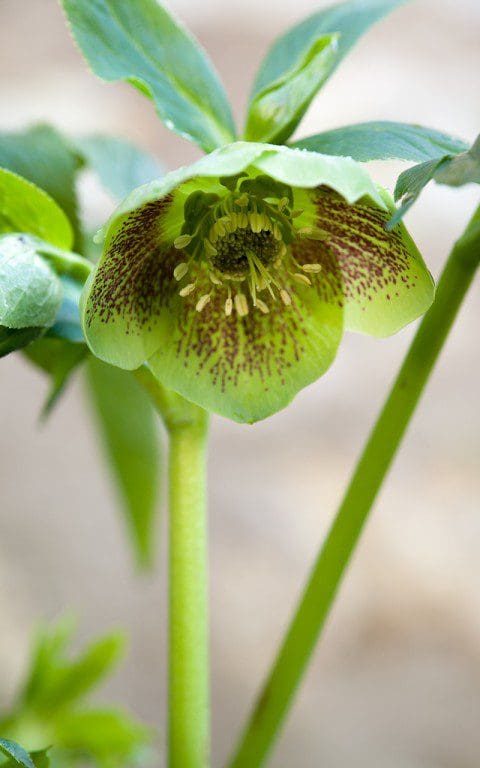 Helleborus x hybridus Single Green Spotted
Helleborus x hybridus Single Green Spotted
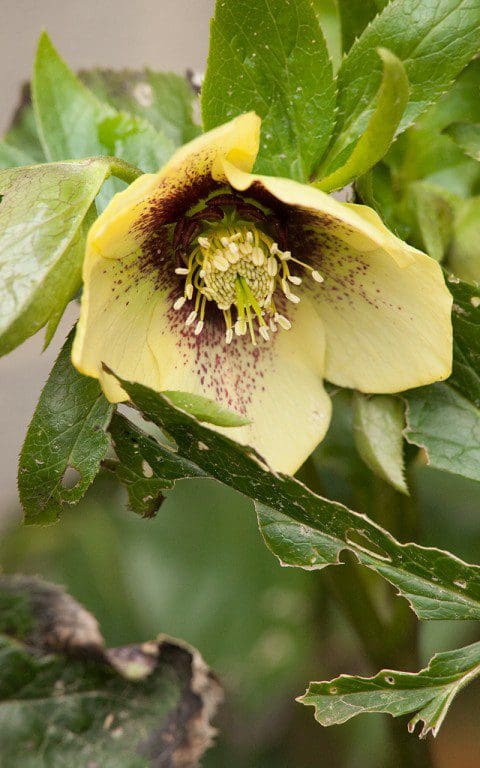 Helleborus x hybridus Single Yellow Spotted Dark Nectaries
Helleborus x hybridus Single Yellow Spotted Dark Nectaries
I soon learned that it was important to hand select seed-raised Helleborus x hybridus since the variability is immense once they start to cross. Seedlings take about three to four years to flower if you are up for the gamble. The colours range from the darkest of slate-greys and plum purples through mauve and then on into a complexity of reds some of which err towards the pink end of the spectrum and others into apricot or the blush of ripe peaches. The yellows, perhaps the most prized due to their rarity, are a relatively recent development. The best hold a strong primrose for the duration of flower, whilst others fade to lime-green. The whites vary too, some clean, some limey, whilst others are infused palest pink. These base colours are sometimes overlaid with delicate veining or picotee edges of a darker tone, whilst the reverse may differ from the interior with a dusting of bloom or staining that gives away nothing of the world within. This is the stuff of obsession once you bend and cup a flower between your fingers to reveal a flash of another colour, a myriad spots or ink-dark nectaries.
An ark of hellebores came here with us from the Peckham garden. Planted on our south-facing slopes in the shade of a trial bed of shrubby willows, I expected them to struggle, but with summer shade they have loved the rich, deep ground and took some moving when they were relocated to their final positions the autumn before last. Moving Lenten Roses is easy if you do it in autumn, ahead of their period of main root activity. This is also the time to split your plants if you want to propagate a particular form, so that by the time they are pushing flowers they will have already found their feet.
The plants I brought with me were old favourites I have collected along the way. A purple as deep as damsons (main image), a slate-grey with bloom to the reverse and a particularly lovely green that has a freckling of burgundy spots within. I grew them all together in Peckham, the green lifting the darkness of the plum and a smattering of snowdrops to light them still further. I also have a fresh, clean white from Home Farm with green veins, and a creamy white picotee rimmed with deep red-violet and veined within. I parted with the dull reds and soft pinks once I’d visited Ashwood Nurseries and encountered the next level.
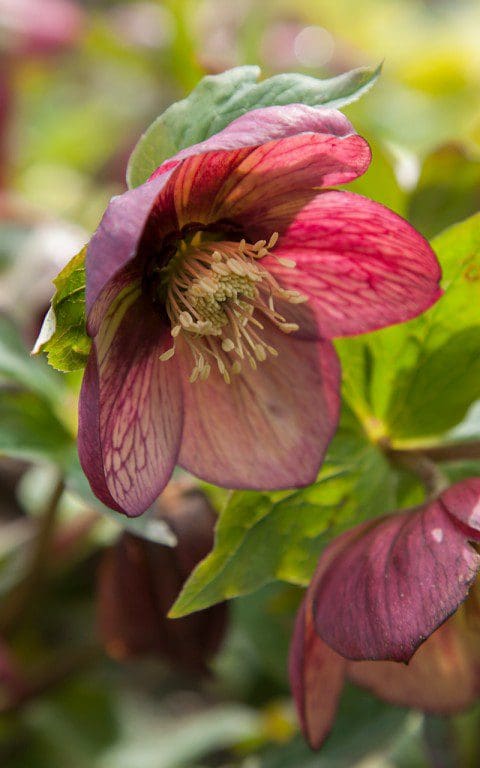 Helleborus x hybridus (Ashwood Evolution Group) Neon Shades
Helleborus x hybridus (Ashwood Evolution Group) Neon Shades
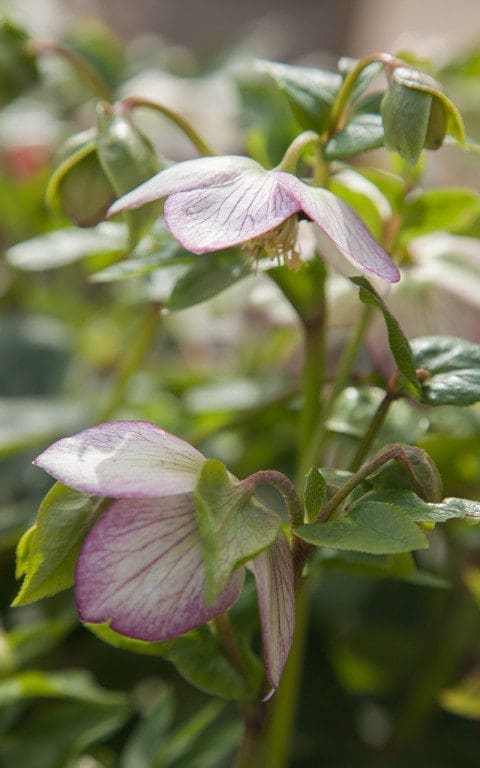 Helleborus x hybridus White Picotee Dark Nectaries
Helleborus x hybridus White Picotee Dark Nectaries
It was February, we had just had our offer accepted on Hillside, and the combination of winter weariness and the prospect of new ground inspired the journey to Ashwood. The nursery is famed for its hellebore selection programme and, within minutes of arriving, it was clear that these plants were far superior. The picotees were more finely drawn, pure whites overlaid with the merest lip of sugar pink, and there were pink and apricot picotees of even greater complexity. After several hours careful deliberation I came away with a number of yellows, selected for their dark plum nectaries, and some clean whites with the same interior stain. In the years since, I have added to the collection with green picotees, yellow spotteds and a number selected specifically for their veining.
As I do not have the luxury of shade, their favoured habitat, I have been winkling my collection in under shrubs or alongside tall, summer perennials that will throw them into cool when their foliage needs protection. Our slopes, however, are ideal for close observation and being able to look up into their blooms is a definite benefit. I have them grouped according to colour, the yellows and the whites alone and the greens and the darkest forms together. Under the medlar I have a collection of deep reds and warm-toned picotees to avoid the collection feeling too much like a sweet box and to allow me the opportunity of stumbling across something different as I move about the garden. Though I am not a fan of the doubles – they feel too cottagey here and too fussy in general – I do have one that is slate-grey which makes the flower very graphic and reminds me of a Louis Poulsen lamp. It has a place of its own under the wintersweet, where I can visit with a different mind-set.
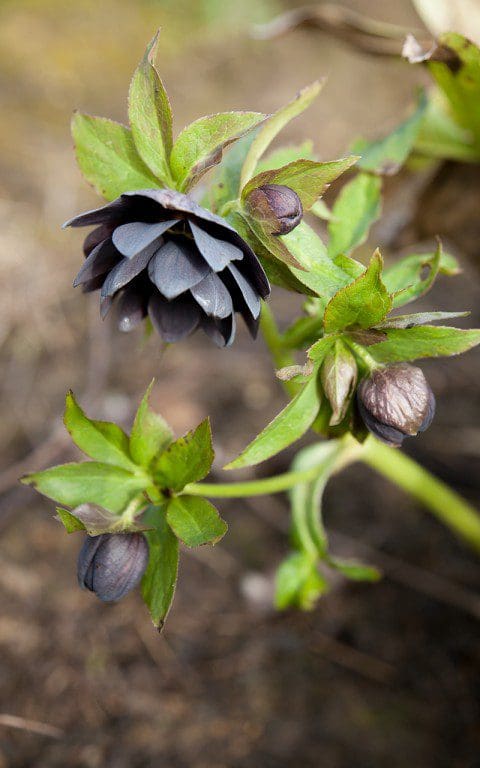 Helleborus x hybridus Double Black
Helleborus x hybridus Double Black
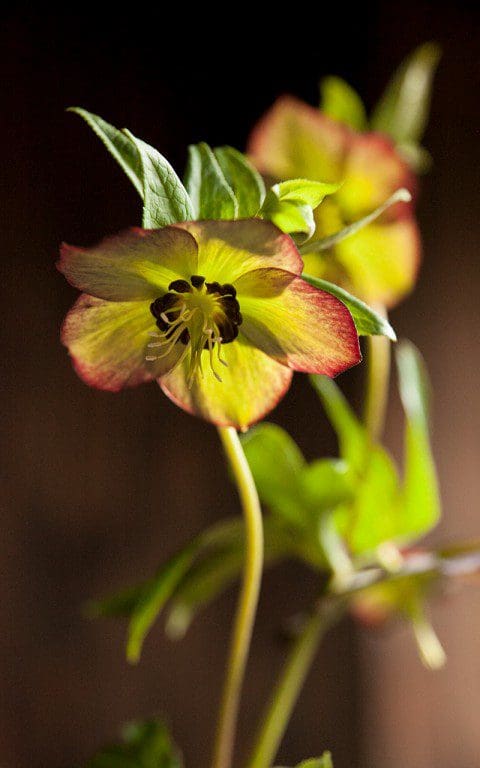 Helleborus x hybridus Single Green Picotee Shades Dark Nectaries
Helleborus x hybridus Single Green Picotee Shades Dark Nectaries
The Lenten Roses are sometimes affected by a blackening on the foliage caused by hellebore leaf spot, which can be debilitating if it gets a hold. Best advice is to remove the foliage in the early winter and burn any affected leaves before the flower stems appear in January. I prefer to let plants settle in for a year or two before removing any foliage, but stripping them back does allow you to see the flower against a clean backdrop. Mulching after the leaves are removed also helps keep the plants moist, but basal rot can be a problem in damp years, so I prefer not to mulch right around the growth to keep the base airy.
For the first time this year, we have been plagued by mice which have stripped the buds of the earliest flowers and robbed me of this year’s respite from the last of the winter. The discovery left me fuming, but there are just enough to pick and float in water. The Lenten rose is not a good cut flower, but the stems are less prone to the flagging if you steep them for thirty seconds in boiling water. We prefer to float the flowers like boats in a shallow dish of water where you can savour their interiors and appreciate the gift they provide in these last few weeks of the season.
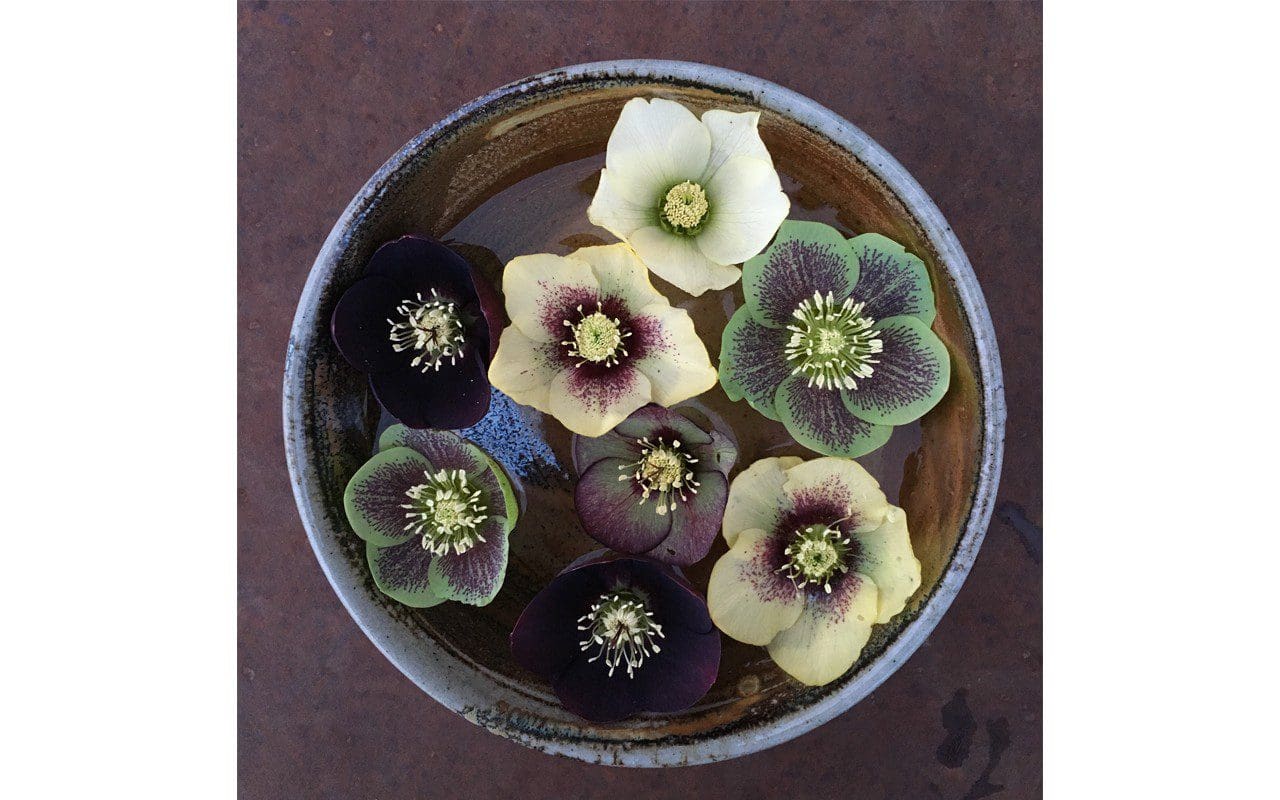
Words: Dan Pearson / Photographs: Huw Morgan
Published 10 February 2018
This first week in the month has brought with it change. The tip in the season is mapped in the scoring of luminous hazel catkins, their streamers hatching verticals into the backdrop of dark wood and hedgerow. These catkins are one of my favourite moments, catching the push of the cold easterlies and the sun when it breaks through the grey. And at their feet, pushing up leaf mould, the snowdrops have made their claim on the shortest month.
Despite the evidence that the grip of winter is loosening, I am always happy to have planned for more. Be it a small effort in the fullness of the previous autumn, a few pots of Iris reticulata are an essential. Just a handful of bulbs is all that is needed to bridge the need for new life and the trickle of spring which, by the time the iris are over, will be sure to be moving and constant.
Hailing from the Middle East, where they bask in winter sunshine when they are in leaf and bake whilst dormant in summer, they are difficult to keep here in the damp of Britain. That said, the bulbs are cheap and easy if you are open to the fact that they are fugitive, so the act of throwing the bulbs after they are over is less guilt-inducing. Plant them deep, to the depth of a trowel in free draining ground and you may have success, but on our hearty soil here they make nothing but leaf in the second year. I prefer the surety of an annual order and the promise they bring to the kitchen table.
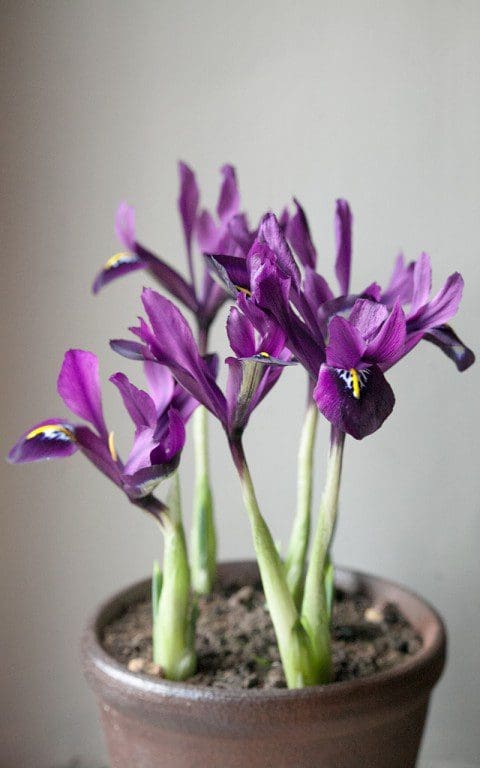
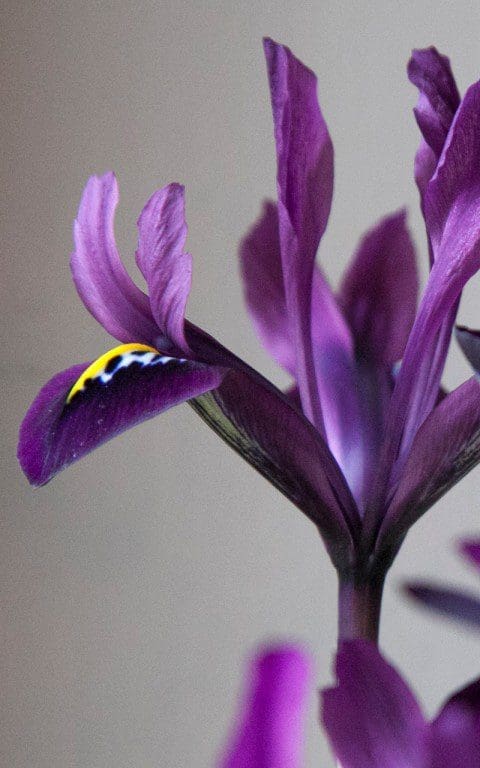 Iris histrioides ‘George’
Iris histrioides ‘George’
I’ve learned over the years that, if you are growing them for display, less is definitely more and that three to five bulbs is enough in a six inch pot. Plant any more and the flowers collide and become confused. The greater part of their charm is in their exquisite outline, slim as pencils when in bud and then pure and finely drawn in their asymmetry once in flower.
Potted in a free-draining compost and kept in a protected place such as the closeness of a house wall or a frame, they need little attention in the first half of winter. Come January, you will see that the spears of foliage have already broken the compost and, towards the end of the month, the tissue-paper sheath reveals the presence of buds held tightly in the base of the leaves. When you see the colour of the buds through the sheath, it is time to bring them in to a cool room to force the flowers and steal a march on the season.
In the warmth, the bud pushes free of its papery protection and rises a little, like a champagne flute on a pale, fine stem so that you can see the full outline. This happens fast when they are ready, over a day or two days at most and, if you are patient, you might witness the flowers open. One fall first, the next and then the third, jerking quietly out and then down to reveal the inner markings. These are exquisite, and variable in the many named varieties, some spotted and flecked, others pure colour broken only by a flame in the throat and the pollen of stamens. Inside, in the still and warmth of a room, you will also catch their delicate perfume. As welcome and as soft as that of primroses and easily lost outside in the blow of an easterly.
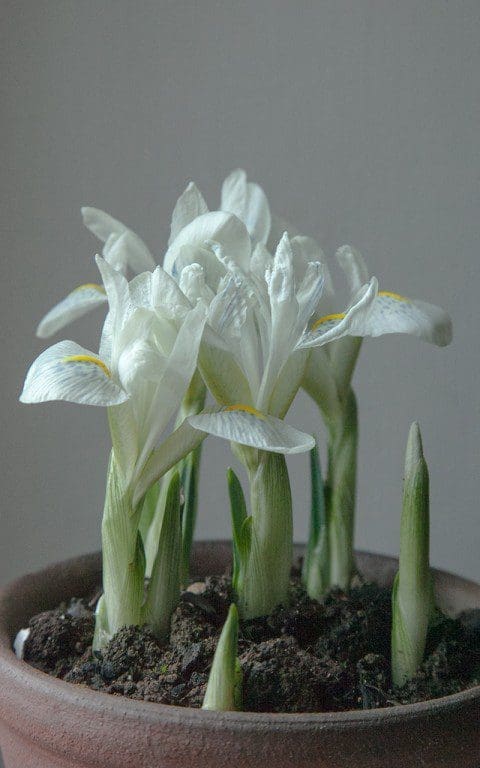
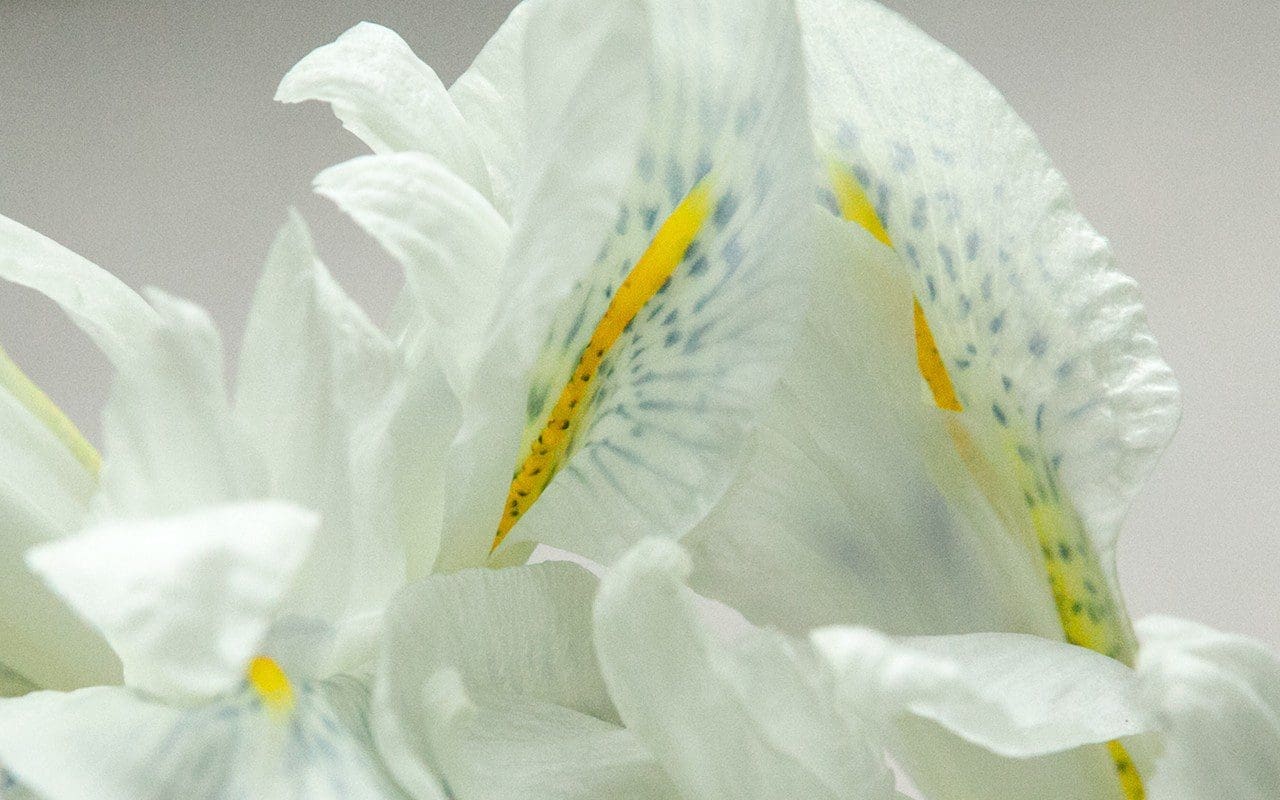 Iris histrioides ‘Finola’
Iris histrioides ‘Finola’
Every year we experiment with a new variety or two, buying ten bulbs of each and three or four varieties at most. We have found our favourites over the years. The slim, dark elegance of ‘J S Dijt’ is one that I would grow every year, and I generally prefer the rich plums of ‘George’ and ‘Pauline’ to the royal and denim blues of ‘Edward’, ‘Gordon’ and ‘Cantab’. However, we loved ‘Blue Note’ last year, with its narrow petals of deepest midnight and ‘Harmony’ (main image) is the quintessential blue spring iris of Japanese woodcuts.
I also have an enduring fondness for the curiosity of ‘Katherine Hodgkin’ with her washed-out, pale blue flowers with greenish veining and yellow leopard spots. Though we do not have it this year, the ghostly mother-of-pearl whiteness of ‘Finola’ is a recent find that I would like to revisit. It is always worth growing something new as there are many to choose from and a wealth of potential future favourites if you see each year as an opportunity for discovery. I already have the clear, sherbet-yellow ‘Katherine’s Gold’ and palest blue ‘Polar Ice’ picked out for next year.
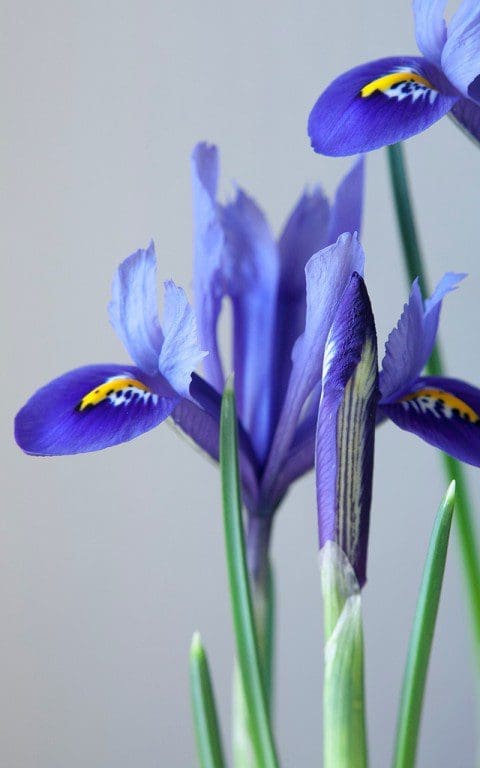 Iris reticulata ‘Harmony’
Iris reticulata ‘Harmony’
As you perfect the art of knowing when to bring them in, you can relay your pots for succession. Though the flowers last just a few days inside, if you have a half dozen pots and keep half in a shadier spot than the others, you will have flower for a fortnight to three weeks. Time enough to bridge the seasons.
Words: Dan Pearson / Photographs: Huw Morgan
Published 3 February 2018
The hamamelis have burst their tight, velvety buds. Huddled darkly along bare branches, it is as if they have waited until we are hungry, our appetites pining for a break with winter. Welcome for the absence of life elsewhere, I fall under their spell again yearly, without fail and willingly. I first encountered them in maturity at Wisley, where in winter they were a mainstay of the winter plant idents, but it was not until my early twenties that I saw the true potential of the witch hazels. My friend Isabelle had taken me to Kalmthout Arboretum in Belgium to meet the owner, Jelena de Belder, the grower of many witch hazels and breeder of several of the best. The first, ‘Ruby Glow’ amongst them, were planted at the arboretum in the 1930s and the De Belders started their own breeding programme in the ’50’s. By the time we saw her collection in the early eighties, they were reaching out in maturity to touch one another, their fiery limbs, on a deep February winter’s day, an unforgettable understorey. The branches were bare and filled with the light of a million tiny filaments. The darkest as deep and red as rubies, and from there running through fire colours from the glow of smouldering embers to incandescent gold, flame yellow and palest sulphur. Writing now with a sprig of ‘Barmstedt Gold’ on the table in front of me, so that I can look in close detail, I remember further back to Geraldine’s Hamamelis mollis. Our neighbour, and my gardening mentor when I was a child, always picked a sprig to enliven her winter table. We would marvel at the strength of the perfume and its combination of delicacy and brazenness pitted against the odds of winter. So my witch hazel affair goes far back, but now is the first real opportunity I’ve had to put a shrub in open ground and be happy in the expectation of its future.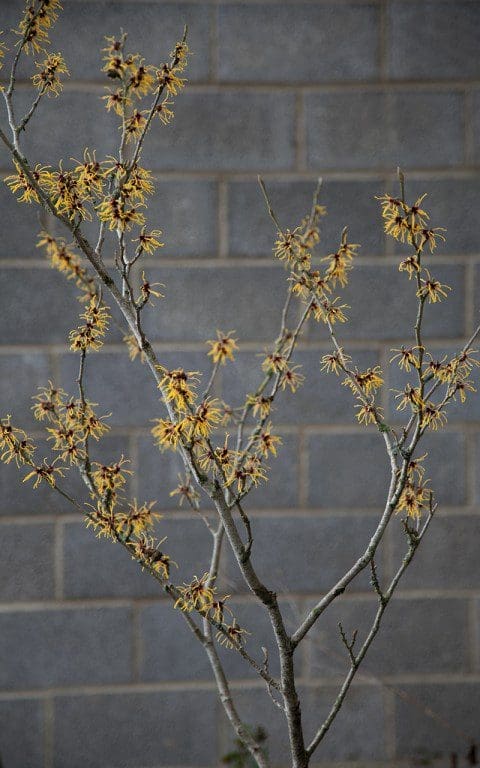
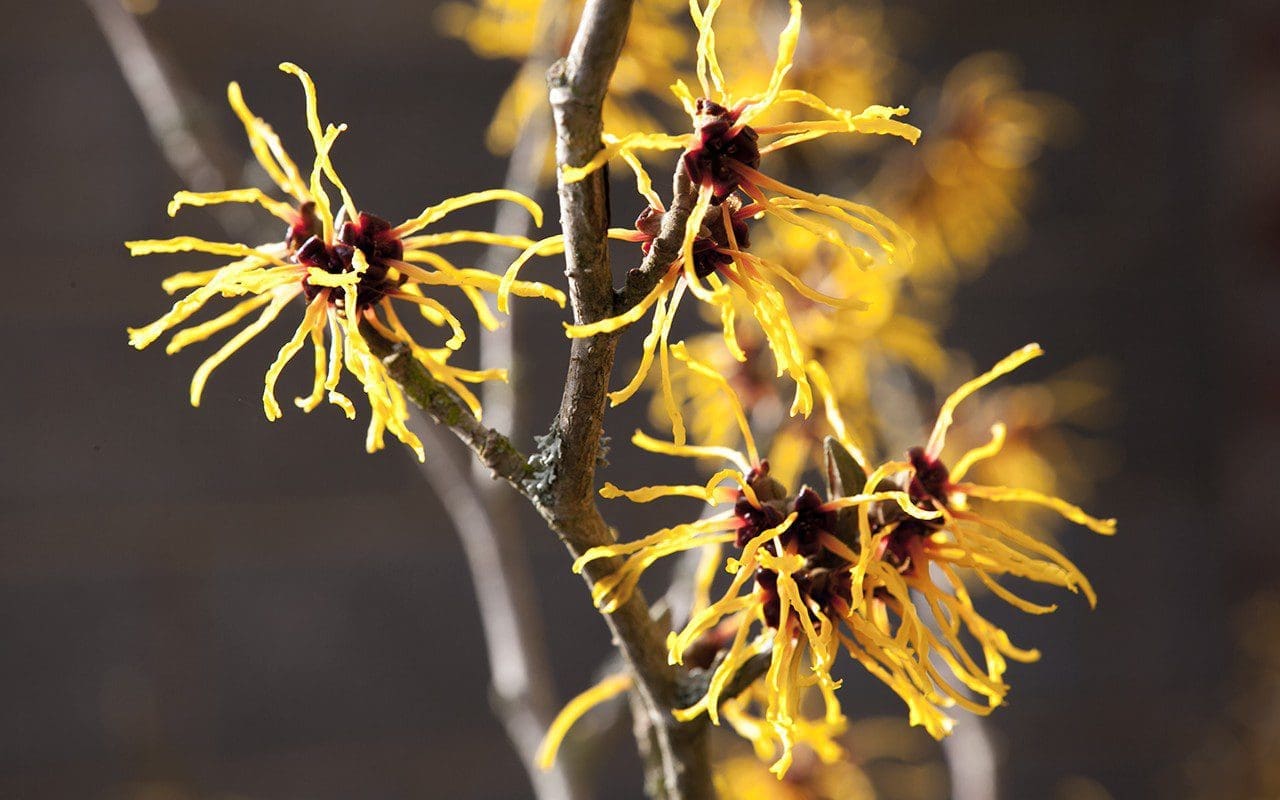 Hamamelis x intermedia ‘Barmstedt Gold’
Hamamelis x intermedia ‘Barmstedt Gold’
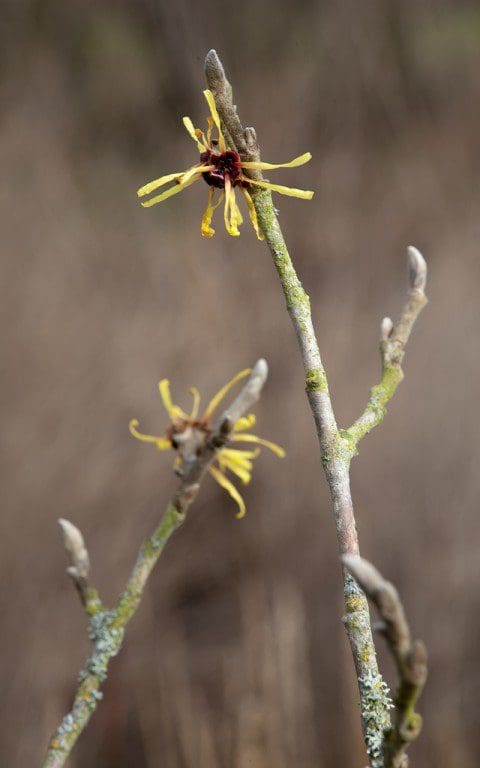 Hamamelis mollis
Before here, in the Peckham garden, I grew hamamelis in pots, because there simply wasn’t space in the beds. They were surprisingly tolerant and it afforded me the opportunity of bringing them up close to the house in the winter to watch their buds unravel at close proximity. ‘Jelena’, a soft orange Hamamelis x intermedia hybrid named after Mme. de Belder, was always the first to flower, before Christmas in London and running through the length of January. It outgrew me, its limbs reaching wide and elegantly in a stretch that became harder and harder to accommodate when I moved it back into the semi-shade at the end of the garden. In the end I gave it away to Nigel Slater when creating a secret garden for him. A good home where I knew he would enjoy it, and every year I am delighted to see him post pictures of the first flowers on Instagram.
H. x intermedia ‘Gingerbread’ (main image) and ‘Barmstedt Gold’, together with a plant of Hamamelis mollis, a gift from Geraldine, came with me from Peckham to here in pots. The intermedia hybrids produce the greater bulk of the coloured varieties but, though they are scented, not all have the pervasive scent of the straight H. mollis. It is often something you have to find and put your nose to, which is why it is worth placing them in a sheltered corner which will hold the perfume, or upwind of where you know you are going to pass. Growing most happily in open woodland, they are adaptable to being out in the open as long as their roots are kept cool and moist in the summer months, and will flower more heavily in the light. Scorched edges to the foliage will show you that they have been under stress and if, like me, you have no choice but to grow them in an open position, this can be alleviated with a summer mulch and long, deep watering when it gets dry.
The books will tell you that they prefer acid soil, but I have found them to be tolerant of alkaline conditions, as long as they have plenty of organic matter in the ground, do not dry out in summer nor lie wet in winter. However, what few books tell you is that they can be short-lived if they find themselves under stress. A tree of thirty years is doing well if you force them too far beyond their comfort zone. They are also slow to attain size, or feel slow because you have an image of wide-spreading limbs in your mind, not the stark twiggery of a young plant. In five to seven years you can begin to see the plant as you want it to be, but if you spend a little more than you’re comfortable with, seeking out a 10 or 15 litre plant that has some substance, the immediate payback is worth it. This year’s purchases – I find it very difficult to resist extending my experience of witch hazels – saw the instant benefits of a waist high ‘Aphrodite’ for nearly £40 and a twig of ‘Orange Peel’ for £15.
Hamamelis mollis
Before here, in the Peckham garden, I grew hamamelis in pots, because there simply wasn’t space in the beds. They were surprisingly tolerant and it afforded me the opportunity of bringing them up close to the house in the winter to watch their buds unravel at close proximity. ‘Jelena’, a soft orange Hamamelis x intermedia hybrid named after Mme. de Belder, was always the first to flower, before Christmas in London and running through the length of January. It outgrew me, its limbs reaching wide and elegantly in a stretch that became harder and harder to accommodate when I moved it back into the semi-shade at the end of the garden. In the end I gave it away to Nigel Slater when creating a secret garden for him. A good home where I knew he would enjoy it, and every year I am delighted to see him post pictures of the first flowers on Instagram.
H. x intermedia ‘Gingerbread’ (main image) and ‘Barmstedt Gold’, together with a plant of Hamamelis mollis, a gift from Geraldine, came with me from Peckham to here in pots. The intermedia hybrids produce the greater bulk of the coloured varieties but, though they are scented, not all have the pervasive scent of the straight H. mollis. It is often something you have to find and put your nose to, which is why it is worth placing them in a sheltered corner which will hold the perfume, or upwind of where you know you are going to pass. Growing most happily in open woodland, they are adaptable to being out in the open as long as their roots are kept cool and moist in the summer months, and will flower more heavily in the light. Scorched edges to the foliage will show you that they have been under stress and if, like me, you have no choice but to grow them in an open position, this can be alleviated with a summer mulch and long, deep watering when it gets dry.
The books will tell you that they prefer acid soil, but I have found them to be tolerant of alkaline conditions, as long as they have plenty of organic matter in the ground, do not dry out in summer nor lie wet in winter. However, what few books tell you is that they can be short-lived if they find themselves under stress. A tree of thirty years is doing well if you force them too far beyond their comfort zone. They are also slow to attain size, or feel slow because you have an image of wide-spreading limbs in your mind, not the stark twiggery of a young plant. In five to seven years you can begin to see the plant as you want it to be, but if you spend a little more than you’re comfortable with, seeking out a 10 or 15 litre plant that has some substance, the immediate payback is worth it. This year’s purchases – I find it very difficult to resist extending my experience of witch hazels – saw the instant benefits of a waist high ‘Aphrodite’ for nearly £40 and a twig of ‘Orange Peel’ for £15.
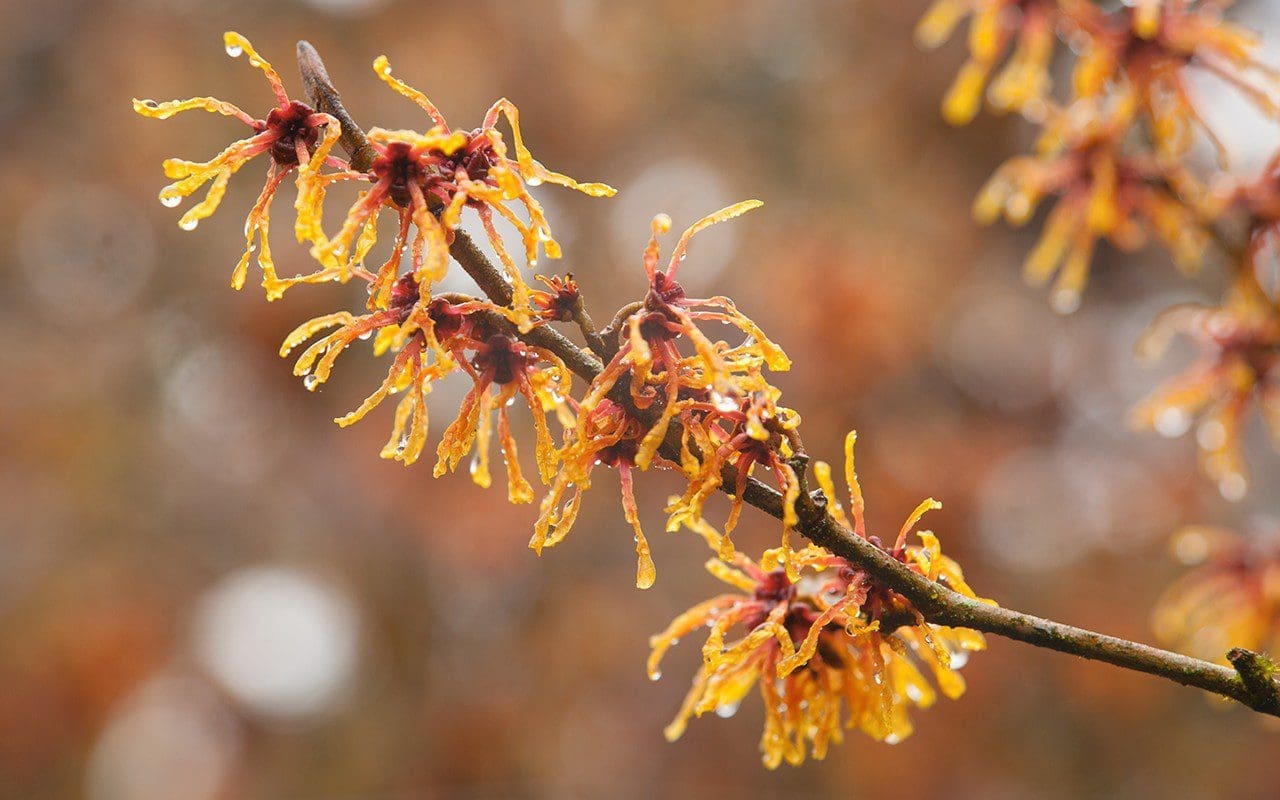 Hamamelis x intermedia ‘Aphrodite’
Hamamelis x intermedia ‘Aphrodite’
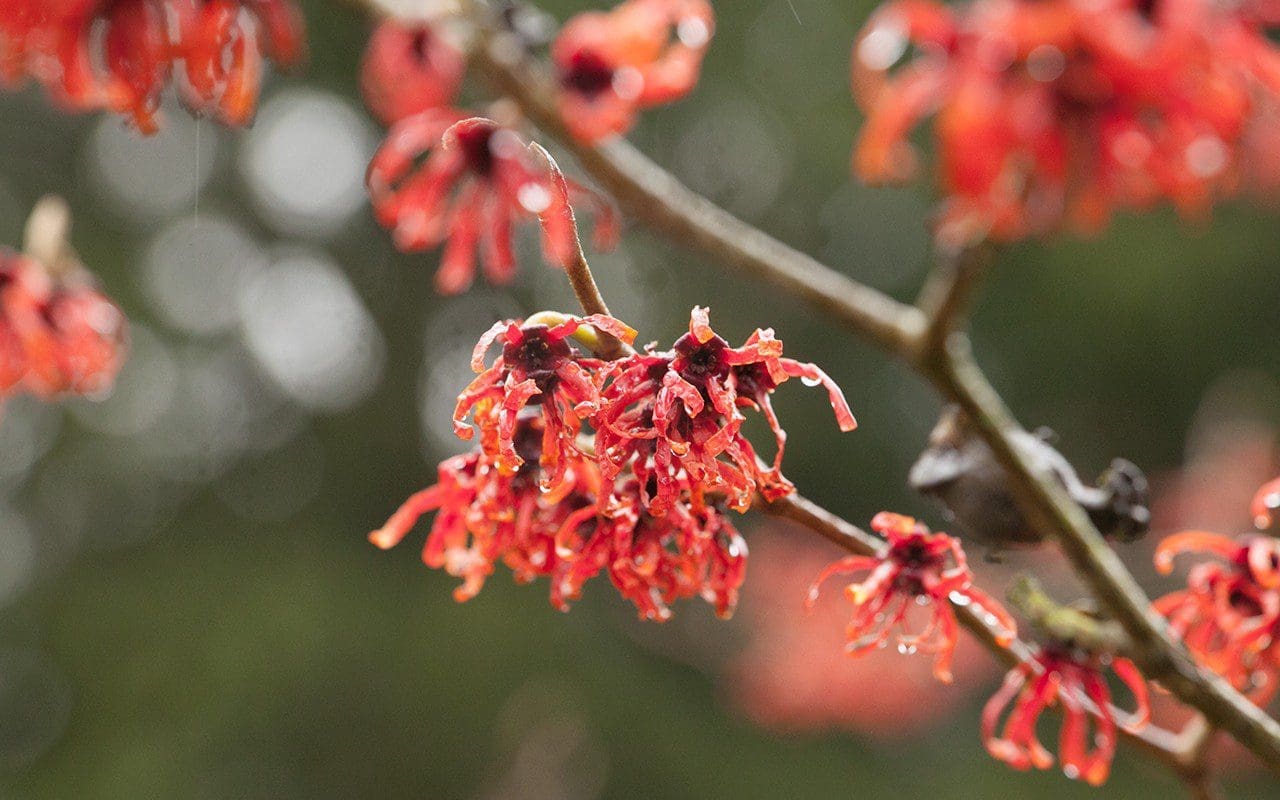 Hamamelis x intermedia ‘Diane’
Choosing the very best of a bewilderingly beautiful bunch is not easy, but my dabbling over the years has been worth it, for the named varieties have very differing habits. Being red-green colour blind, and losing some but not all reds, I must try hard to find ‘Diane’ when planted out in a garden. Up close I can see it is a wonderful colour and often use it for clients, but it is not one that I gravitate to for myself. It has a well-behaved, rounded habit and reliably scarlet autumn foliage, which singles it out as a variety to return to for two seasons of interest.
Several of the intermedia hybrids are problematic in my opinion for not losing leaves in winter, hanging on too long, like hornbeam or beech, to clutter what should be a naked stage of branches for the flowers. I have found that they do this in some gardens and not others and often they grow out of it as they mature, but I prefer the varieties that drop properly and most enjoy those that colour well in the autumn.
Hamamelis x intermedia ‘Diane’
Choosing the very best of a bewilderingly beautiful bunch is not easy, but my dabbling over the years has been worth it, for the named varieties have very differing habits. Being red-green colour blind, and losing some but not all reds, I must try hard to find ‘Diane’ when planted out in a garden. Up close I can see it is a wonderful colour and often use it for clients, but it is not one that I gravitate to for myself. It has a well-behaved, rounded habit and reliably scarlet autumn foliage, which singles it out as a variety to return to for two seasons of interest.
Several of the intermedia hybrids are problematic in my opinion for not losing leaves in winter, hanging on too long, like hornbeam or beech, to clutter what should be a naked stage of branches for the flowers. I have found that they do this in some gardens and not others and often they grow out of it as they mature, but I prefer the varieties that drop properly and most enjoy those that colour well in the autumn.
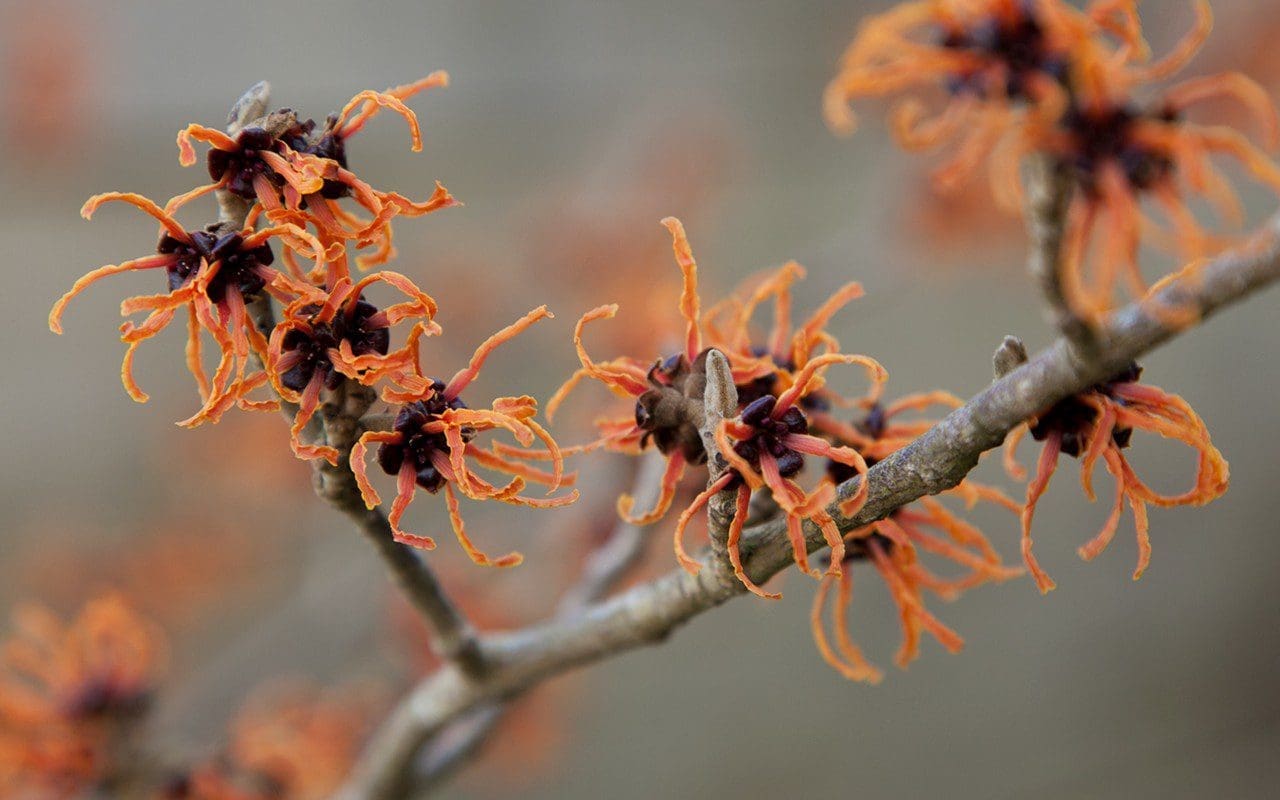 Hamamelis x intermedia ‘Gingerbread’
My plants here will be happy in our retentive loam despite the exposure, but I do mulch heavily with compost to emulate their natural wooded habitat. They have been planted here not only for the winter draw they provide, but also for the benefit of shade they bring to plants around them come summer. Rooting lightly and without heavy competition, they will provide home to spring flowering pulmonaria and erythronium which will come as they fade. The foliage of ‘Gingerbread’ has a copper flush as it comes into leaf, which is good with the Bath Asparagus planted beneath it, but later in the summer the branches provide a frame for Tropaeolum speciosum. The Flame Flower makes the branches flare again, when I have all but forgotten the winter spell that I am bewitched by today.
Words: Dan Pearson / Photographs: Huw Morgan
Published 27 January 2018
Hamamelis x intermedia ‘Gingerbread’
My plants here will be happy in our retentive loam despite the exposure, but I do mulch heavily with compost to emulate their natural wooded habitat. They have been planted here not only for the winter draw they provide, but also for the benefit of shade they bring to plants around them come summer. Rooting lightly and without heavy competition, they will provide home to spring flowering pulmonaria and erythronium which will come as they fade. The foliage of ‘Gingerbread’ has a copper flush as it comes into leaf, which is good with the Bath Asparagus planted beneath it, but later in the summer the branches provide a frame for Tropaeolum speciosum. The Flame Flower makes the branches flare again, when I have all but forgotten the winter spell that I am bewitched by today.
Words: Dan Pearson / Photographs: Huw Morgan
Published 27 January 2018 Late in December, and before I expected such a prompt return, the Cyclamen coum made their re-appearance. The tiny beaks of magenta broke bare earth, buds soon reflexing to flower, sturdy and gathering in number and oblivious, it seemed, to the winter. Of all the flowers that come in these darkest weeks Cyclamen coum seem to have the most stamina, flowering for what must be the best part of three months and, in that time, providing a continuity of hope. During their season, they will see the snowdrops in and out and be companion to witch hazel and wintersweet and be happy to be in the root zone where little else will grow.
The rooty places where the ground is already taken are where they prefer to be. Here they will spend their summer dormancy underground, their tubers kept cool but on the dry side and in perfect stasis. Come the autumn rains their season is activated and, without the competition of summer growth either above or around them, they are free to flower and build up a colony. Choosing the place where they can be allowed to reign is the secret and it has taken a while for me to find the perfect spot under the old hollies. The ground is steeply sloped here and the trees, with their high dense canopy and fibrous roots, make for strong competition.
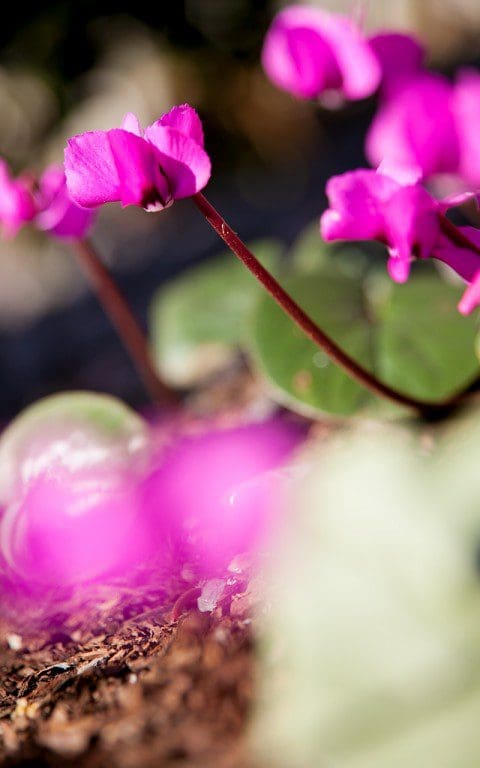 Cyclamen coum
Cyclamen coum
Cyclamen are always best planted when in growth and not bought as dormant tubers, which have often been kept too dry for too long by the suppliers. Hailing as they do from the Caucasus, Turkey, the Lebanon and Israel Cyclamen coum prefer to be kept on the dry side when dormant, which is easier and less disruptive in a pot. The second advantage to planting when they are in growth is that you can hand-pick for best leaf variation and flower colour. The leaves are as variable as pebbles on a beach. Some, often sold as the ‘Pewter Group’, are almost completely silvered, others are green overlaid with silver, and others almost entirely bottle-green. The foliage, which is the size of a chocolate coin and held close to the ground, doesn’t like competition and you have to be careful not to team them with the leafier Cyclamen hederifolium which is more vigorous and will smother them or with other winter flowering bulbs such as Eranthis, which are prone to leafiness once they start to form seed.
A dozen plants were winkled in where I could find gaps between the holly roots last winter and top-dressed with a mix of gravel and bark to do no more than cover the tubers. I hand-picked my plants for the strong magenta forms, as I prefer the punch of their pure, bright colour to the softening influence of the paler pinks and white, which is what you more often see where they have naturalised. Last year’s plants have all returned with a clutch of seedlings held tight within their crowns. These miniature new plants look true to type (or more-of-less) in terms of leaf marking, but I will see in three years or so if the flowers are true to their magenta parents.
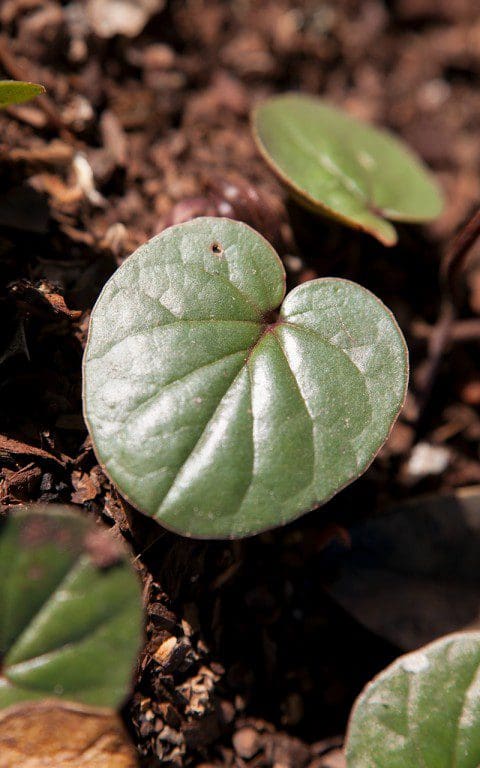
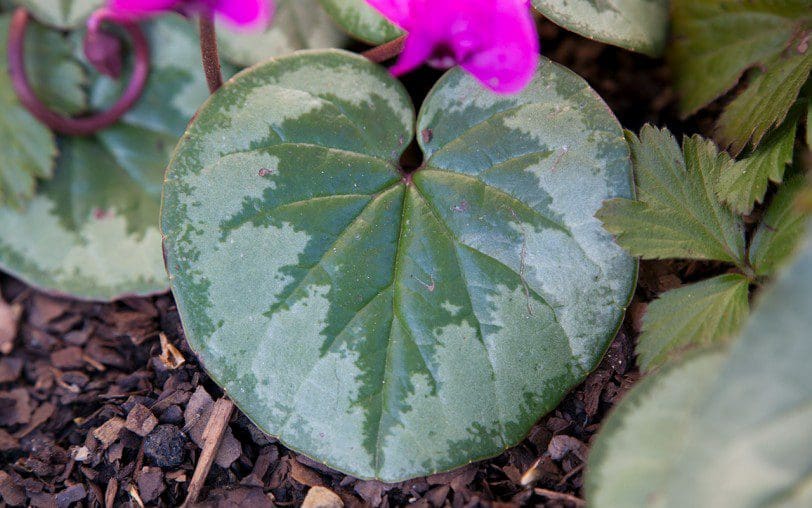
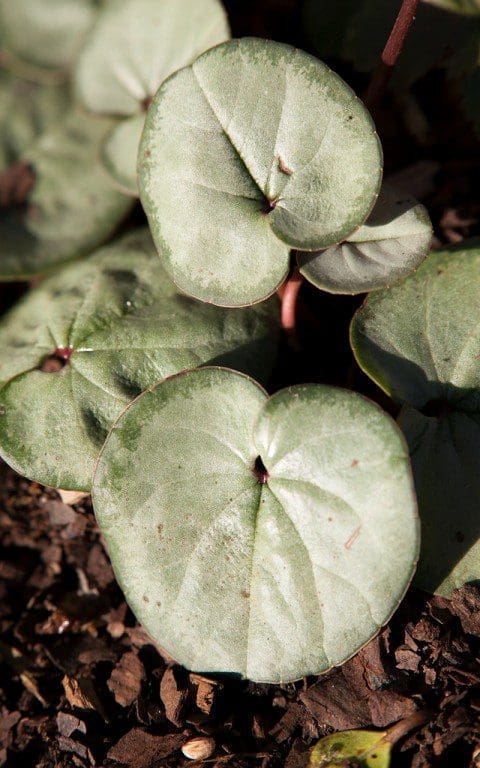 Various foliage colouration
Various foliage colouration
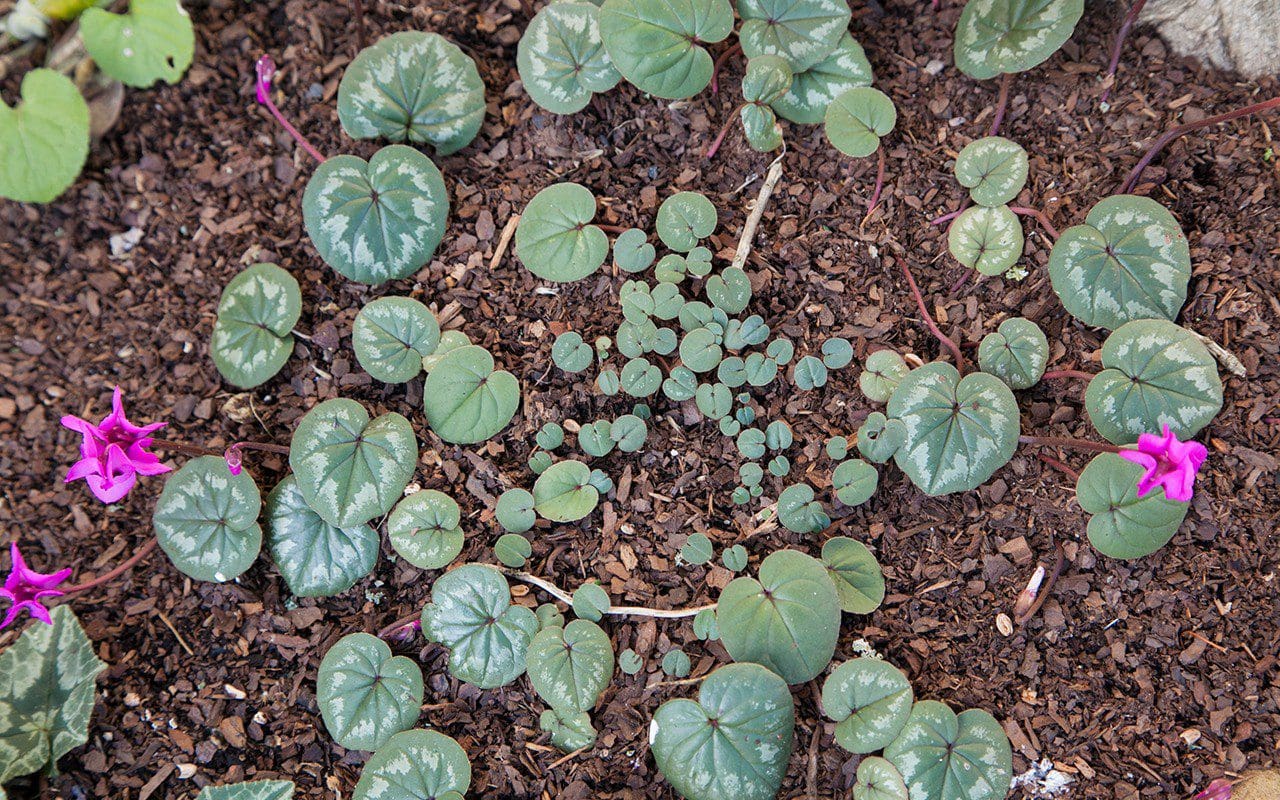 Seedlings have appeared in the crowns of last year’s plants
Seedlings have appeared in the crowns of last year’s plants
Tania Compton has raved to me about her Cyclamen coum naturalising best in pure gravel and I have hopes that mine will break free from their mound under the holly and venture into the sleeper steps that run alongside, their rubbly treads being the perfect habitat for them to run free. Cyclamen are prolific seeders if they decide they like you and a sweet coating on the seed makes them a delicacy for ants which will carry them quite some distance, so that they often appear in surprising and unexpected places. I have an image of the steps in a few years’ time being somewhere that you have to pick your way down in the winter as though on a glowing magenta runner, threadbare where our footfall influences where the cyclamen appear and where they don’t.
Words: Dan Pearson / Photographs: Huw Morgan
Published 13 January 2018
Not long after moving here, Jane, our friend and neighbour, took us for a walk into the woods in a nearby valley to see the green hellebore. We pulled off the lane and set off on foot along a well-worn way up into the trees. The north-facing slope had an inherent chill that set it apart from our south-facing slopes and the tree trunks and every stationary object were marked with a sheath of emerald moss.
The track made its way up steeply into ancient coppice. Land too steep to farm and questionably accessible even for sheep. Fallen trunks from a previous age and splays of untended hazels marked the decades that the land had been left to go wild. At least wild in the way that nowhere is truly wild on our little island of managed land. I knew the woods, for we had been here before in summer to look at the fields of orchids that colonise the open grassland above, where the hill flattens out into fenced paddocks. The woods are not extensive, but large enough to have their own environment in this steep fold in the land.
Somewhere near the top of the hill, with the light from the field above us just visible through the tangle of limbs, we set off sideways onto the slopes. The angle was steep enough not to have to bend too far to steady yourself with your hands, but consequently required a firm foothold when inching along the contour. Deep into the trees we came upon our goal. Nestled in under the roots of ancient coppiced hazel and up and out with the very first catkins, the Helleborus viridis.
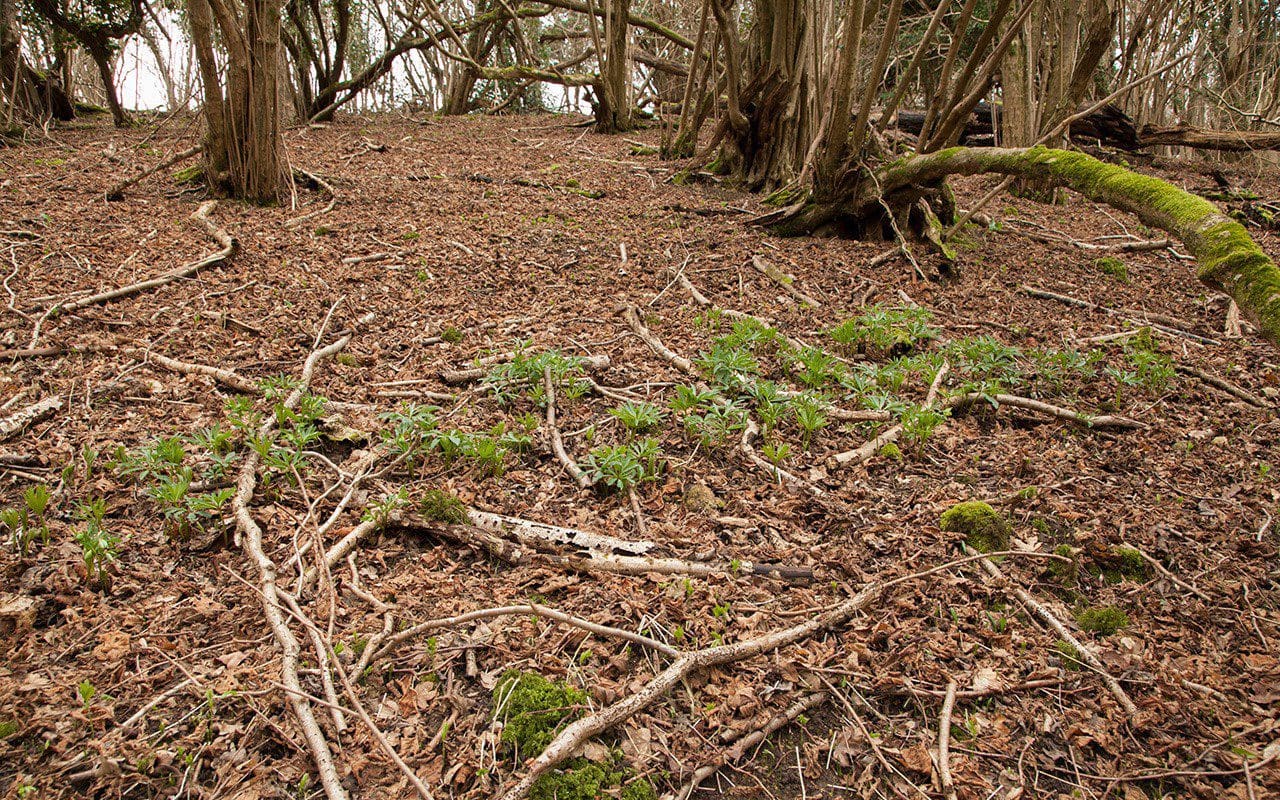
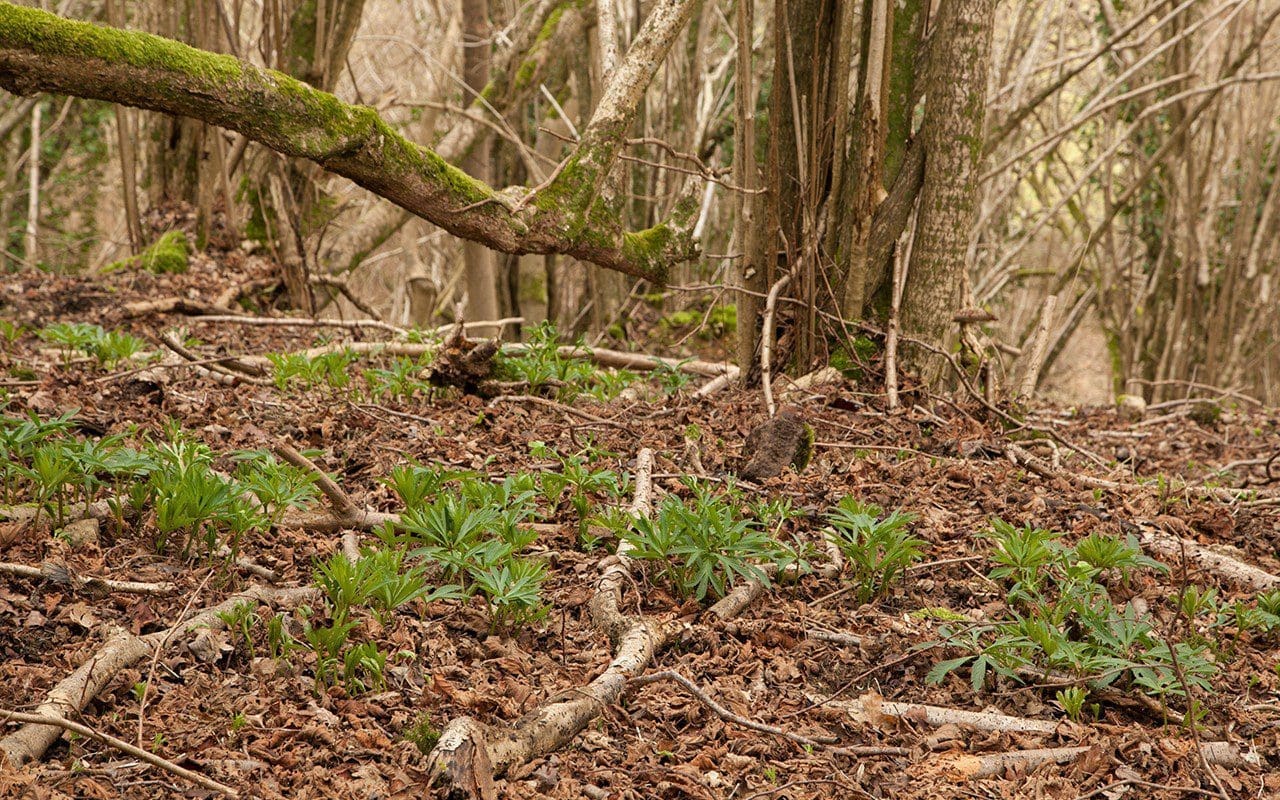 A wild colony of green hellebore in the local woods
A wild colony of green hellebore in the local woods
To find a plant growing in the wild where it has found it’s niche is to truly understand its habits and requirements. Dry descriptions of habitats and associations in books instantly give way to a greater knowledge, for you never forget when you see a plant looking right in its place. In the cool of the north-facing slope and shaded not only by the deciduous canopy above, but also by the bole of the hazel and its influence, the hellebore was at home. With no competition to speak of, protected by damp leaf mould and with its roots firmly holding in the limestone of the hill, it was king of its place. New foliage, soft and emerald green, splayed fingers of early life. The nodding flowers, concealing the stamens, held free of the ground foliage on arching stems. Viridis, meaning green, is the colour of all its parts; a welcome one at the end of a long winter and a sure sign that the season is ebbing.
Several weeks later I returned in search of seed. The woods were flushed with first leaf which darkened the slopes. Nettles, already fringing the woodland edge where the light penetrated alongside the path, were ready to sting. But deep where the hellebores were growing, they were still in glorious isolation with little more than a few celandine and wood anemone for company. The flowers were transformed, the lanterns replaced by a rosette of bladders which were just turning from green to brown. I cupped my hand underneath and tapped. A slick trickle of ebony seed settled into the crease of my palm.
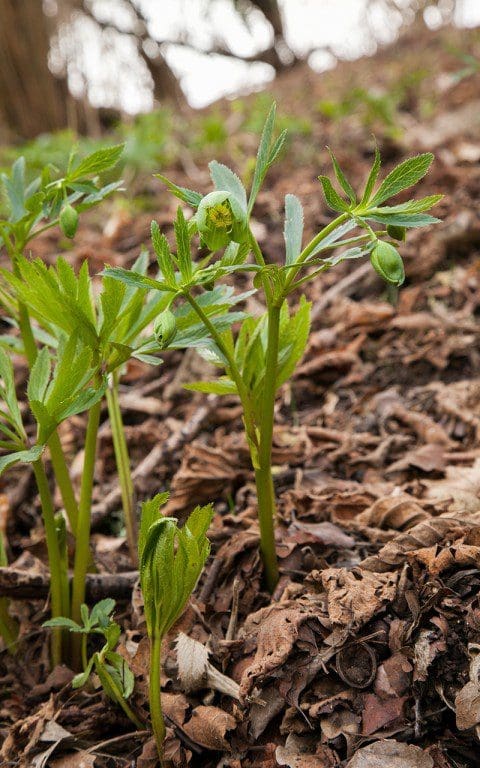 Green hellebore – Helleborus viridis ssp. occidentalis
Green hellebore – Helleborus viridis ssp. occidentalis
The seed of plants in the family Ranunculaceae is famously short-lived so I sowed it on the same day it was harvested, covered with grit and put in a shady place out of harm’s way. Three seasons later, the following March, it germinated with some success. I kept it in the shade on the north side of the house to throw its first leaves without disturbance. A year later I had seedlings that were ready to pot up and a year after that, to plant out. Jane took a number of the seedlings to start a colony on the north-facing wooded slopes that run up from our shared boundary, the stream. I planted the banks on our side, where the tree canopy provides the shelter, summer shade and leaf litter they need to do well. This year they are flowering for the first time in earnest and, with luck, will set seed and start spreading.
Though they were once used for their purgative qualities (as a folk remedy for worms and the topical treatment of warts), Gilbert White pointed to the fact that it is toxic in all its parts. ‘Where it killed not the patient, it would certainly kill the worms; but the worst of it is, it will sometimes kill both.’ With this in mind, I have kept it away from the sheep and have noted that, even down by the stream where the deer have their run, it remains completely untouched despite its lush, early growth.
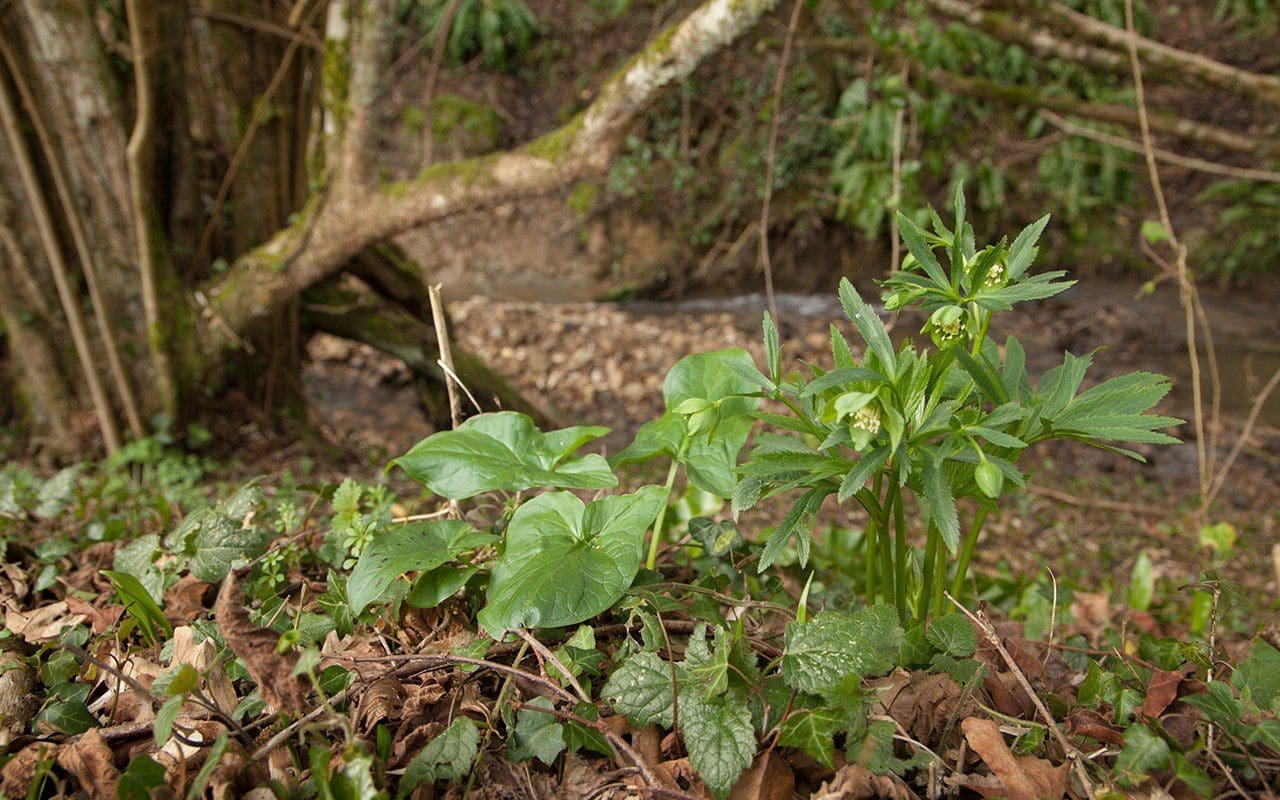 One of the young seed grown green hellebores down by the stream
One of the young seed grown green hellebores down by the stream
Though rare in limestone woods in southern England, it is more common in parts of mainland Europe*. Cedric Morris found them in the Picos de Europa growing with a dark form of Erythronium dens-canis; a companion planting it would be hard to emulate here, because of the rush of growth that happens after snowmelt when everything comes at the same time. Its demure nature does not make it a match for the Lenten roses I have here in the garden, which feel rather opulent in comparison. However, I like it very much for its earliness, for its modest break with winter and particularly for the fact that it is native. Where my plants are establishing themselves amongst the newly emerging Arum italicum and an occasional primrose I find great excitement in the thought that spring is now unstoppable.
Words: Dan Pearson / Photographs: Huw Morgan
We are sorry but the page you are looking for does not exist. You could return to the homepage